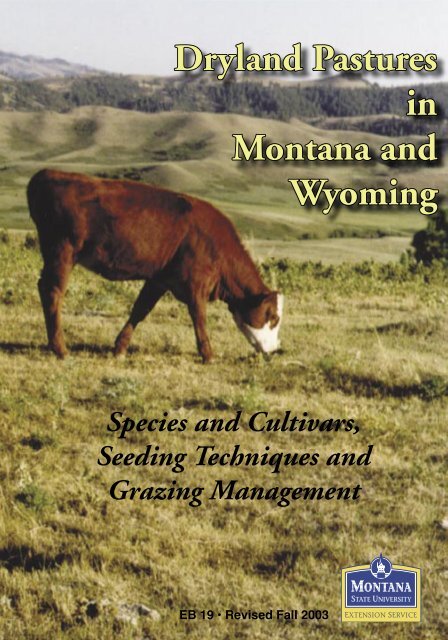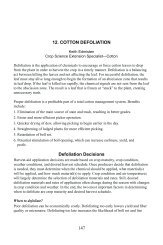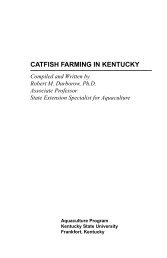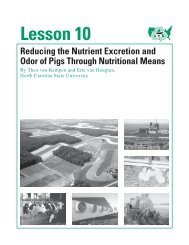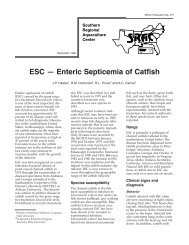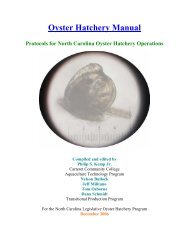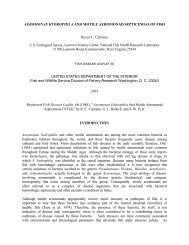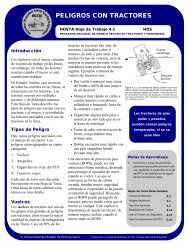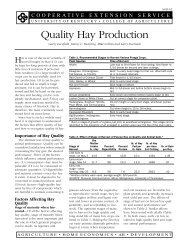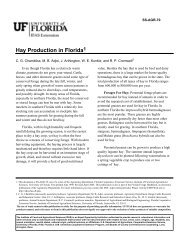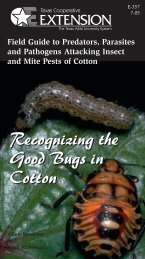Dryland Pastures in Montana and Wyoming - MSU Extension
Dryland Pastures in Montana and Wyoming - MSU Extension
Dryland Pastures in Montana and Wyoming - MSU Extension
Create successful ePaper yourself
Turn your PDF publications into a flip-book with our unique Google optimized e-Paper software.
<strong>Dryl<strong>and</strong></strong> <strong>Pastures</strong><br />
<strong>in</strong><br />
<strong>Montana</strong> <strong>and</strong><br />
Wyom<strong>in</strong>g<br />
Species <strong>and</strong> Cultivars,<br />
Seed<strong>in</strong>g Techniques <strong>and</strong><br />
Graz<strong>in</strong>g Man age ment<br />
EB 19 • Revised Fall 2003
This <strong>in</strong>formation is for educational purposes only.<br />
Reference to commercial products or trade names does not<br />
imply discrim<strong>in</strong>ation or endorsement by the <strong>Montana</strong> State<br />
University <strong>Extension</strong> Service.<br />
Copyright © 2003. While we encourage the use of this document for non-profit educational<br />
purposes, we reserve the right to restrict the unlawful reproduction of this document <strong>in</strong> pr<strong>in</strong>t or<br />
electronic format.<br />
To reproduce all or parts of this document, you must seek permission from the Ag/<strong>Extension</strong><br />
Communications Coord<strong>in</strong>ator, Communications Services, 416 Culbertson Hall, <strong>Montana</strong> State<br />
University-Bozeman, Bozeman, MT 59717; (406) 994-5132; E-mail - publications@montana.edu.<br />
The programs of the <strong>Montana</strong> State University <strong>Extension</strong> Service are available to all people<br />
regardless of race, creed, color, sex, disability or national orig<strong>in</strong>. Issued <strong>in</strong> furtherance of cooperative<br />
extension work <strong>in</strong> agriculture <strong>and</strong> home economics, acts of May 8 <strong>and</strong> June 30, 1914,<br />
<strong>in</strong> cooperation with the U.S. Department of Agriculture, LeRoy D. Luft, Interim Vice Provost <strong>and</strong><br />
Director, <strong>Extension</strong> Service, <strong>Montana</strong> State University, Bozeman, <strong>Montana</strong> 59717.<br />
The U. S. Department of Agriculture (USDA) prohibits discrim<strong>in</strong>ation <strong>in</strong> all its programs <strong>and</strong> activities<br />
on the basis of race, color, national orig<strong>in</strong>, gender, religion, age, disability, political beliefs,<br />
sexual orientation, or marital or family status. (Not all prohibited bases apply to all programs.)<br />
Persons with disabilities who require alternative means for communication of program <strong>in</strong>formation<br />
(Braille, large pr<strong>in</strong>t, audiotape, etc.) should contact USDAʼs Target Center at (202) 720-2600<br />
(voice <strong>and</strong> TDD).<br />
To file a compla<strong>in</strong>t of discrim<strong>in</strong>ation, write USDA, Director, Office of Civil Rights, Room 326-W,<br />
Whitten Build<strong>in</strong>g, 14th <strong>and</strong> Independence Avenue, SW, Wash<strong>in</strong>gton, DC 20250-9410 or call<br />
(202) 720-5964 (voice <strong>and</strong> TDD). USDA is an equal opportunity provider <strong>and</strong> employer.
<strong>Dryl<strong>and</strong></strong> <strong>Pastures</strong><br />
<strong>in</strong> <strong>Montana</strong> <strong>and</strong> Wyom<strong>in</strong>g<br />
Species <strong>and</strong> Cultivars,<br />
Seed<strong>in</strong>g Techniques <strong>and</strong> Graz<strong>in</strong>g Management<br />
by Larry Holzworth, Jeff Mosley, Dennis Cash,<br />
David Koch <strong>and</strong> Kelly Crane*<br />
* Plant materials specialist, Natural Resources Conservation Service, Bozeman,<br />
MT; <strong>Extension</strong> range management specialist, <strong>Montana</strong> State University-Bozeman;<br />
<strong>Extension</strong> forage specialist, <strong>Montana</strong> State University-Bozeman; <strong>Extension</strong><br />
forage specialist, University of Wyom<strong>in</strong>g-Laramie; <strong>and</strong> former <strong>Extension</strong> range<br />
management specialist, University of Wyom<strong>in</strong>g-Laramie, respectively.<br />
— 1 —
— 2 —
Contents<br />
Introduction............................................ 5<br />
Seed<strong>in</strong>g Objectives................................. 5<br />
• Forage Needs ................................ 6<br />
• Site Selection ................................ 6<br />
• Profitability ................................... 6<br />
—Anticipated benefits ............. 6<br />
—Anticipated costs.................. 6<br />
—Cost/benefit analysis ............ 7<br />
Selection of Species <strong>and</strong> Cultivars......... 7<br />
Season of Use......................................... 7<br />
Precipitation ......................................... 12<br />
Soils ..................................................... 14<br />
Mixtures ............................................... 14<br />
Cultivars............................................... 15<br />
Seedl<strong>in</strong>g Establishment........................ 15<br />
• Seed Source................................. 15<br />
• Seed<strong>in</strong>g Rates ............................. 16<br />
• Site Preparation........................... 16<br />
• Tim<strong>in</strong>g of Seed<strong>in</strong>g....................... 17<br />
• Row Spac<strong>in</strong>g .............................. 17<br />
• Seed Placement ........................... 17<br />
• Fertilizer...................................... 18<br />
• Weed Control .............................. 18<br />
Established St<strong>and</strong> Management ........... 18<br />
Graz<strong>in</strong>g Management........................... 19<br />
• Tim<strong>in</strong>g of Graz<strong>in</strong>g....................... 19<br />
• Graz<strong>in</strong>g Intensity......................... 21<br />
• Rotational Graz<strong>in</strong>g ...................... 21<br />
• Graz<strong>in</strong>g Selectivity...................... 22<br />
Figure 1. Performance of commonly<br />
seeded species <strong>in</strong> different ra<strong>in</strong>fall<br />
zones.............................................. 13<br />
Figure 2. Performance of commonly used<br />
species <strong>in</strong> different soil types ........ 13<br />
Figure 3. M<strong>in</strong>imum leaf or stubble height<br />
at the beg<strong>in</strong>n<strong>in</strong>g <strong>and</strong> end of graz<strong>in</strong>g<br />
dur<strong>in</strong>g the grow<strong>in</strong>g season............. 20<br />
Table 1. Native cool-season grasses for<br />
dryl<strong>and</strong> pastures <strong>in</strong> <strong>Montana</strong> <strong>and</strong><br />
Wyom<strong>in</strong>g ......................................... 8<br />
Table 2. Native warm-season grasses<br />
for dryl<strong>and</strong> pastures <strong>in</strong> <strong>Montana</strong> <strong>and</strong><br />
Wyom<strong>in</strong>g ......................................... 9<br />
Table 3. Introduced grasses for dryl<strong>and</strong> pastures<br />
<strong>in</strong> <strong>Montana</strong> <strong>and</strong> Wyom<strong>in</strong>g.......10<br />
Table 4. Forbs <strong>and</strong> shrubs for dryl<strong>and</strong> pastures<br />
<strong>in</strong> <strong>Montana</strong> <strong>and</strong> Wyom<strong>in</strong>g ...... 11<br />
Table 5. Stock<strong>in</strong>g rate guidel<strong>in</strong>es for dryl<strong>and</strong><br />
pastures <strong>and</strong> crop aftermath... 21<br />
Table 6. A two-pasture rotational graz<strong>in</strong>g<br />
program ......................................... 22<br />
Table 7. A three-pasture rotational graz<strong>in</strong>g<br />
program for non-coarse plant species<br />
....................................................... 22<br />
Table 8. A three-pasture rotational graz<strong>in</strong>g<br />
program for “coarse” plant<br />
species ........................................... 22<br />
Appendix A. Descriptions of the dryl<strong>and</strong><br />
forage cultivars most commonly used<br />
<strong>and</strong> recommended <strong>in</strong> <strong>Montana</strong> <strong>and</strong><br />
Wyom<strong>in</strong>g ...................................... 23<br />
— 3 —
— 4 —
<strong>Dryl<strong>and</strong></strong> <strong>Pastures</strong><br />
<strong>in</strong> <strong>Montana</strong> <strong>and</strong> Wyom<strong>in</strong>g<br />
Species <strong>and</strong> Cultivars,<br />
Seed<strong>in</strong>g Techniques <strong>and</strong> Graz<strong>in</strong>g Management<br />
Profitable ranch<strong>in</strong>g depends upon the management of l<strong>and</strong>, livestock, f<strong>in</strong>ancial<br />
<strong>and</strong> human resources. To be economically <strong>and</strong> ecologically successful, ranchers<br />
must adapt to their environment <strong>and</strong> develop a well-balanced, year-round forage<br />
plan that satisfies livestock nutrient requirements <strong>and</strong> at the same time susta<strong>in</strong>s<br />
forage resources. Forage resources <strong>in</strong>clude hayl<strong>and</strong>, rangel<strong>and</strong>, crop aftermath <strong>and</strong><br />
seeded pastures.<br />
Seeded pastures can supply nutritious forage at times dur<strong>in</strong>g the year when<br />
other sources are <strong>in</strong>adequate or unavailable. This requires <strong>in</strong>tegrat<strong>in</strong>g seeded pastures<br />
<strong>in</strong>to the total ranch operation. To ensure a satisfactory return for each dollar<br />
<strong>in</strong>vested, seeded species must be adapted to the site’s soil, hydrology <strong>and</strong> climate,<br />
fit a rancher’s needs <strong>and</strong> be properly established <strong>and</strong> managed.<br />
Local experience, observations <strong>and</strong> research should be considered when plant<strong>in</strong>g<br />
<strong>and</strong> manag<strong>in</strong>g dryl<strong>and</strong> pastures. A four-step process maximizes the effectiveness<br />
of dryl<strong>and</strong> pasture seed<strong>in</strong>gs:<br />
1) determ<strong>in</strong>e seed<strong>in</strong>g objectives,<br />
2) select the appropriate species <strong>and</strong> cultivar(s) for the site <strong>and</strong> the objectives,<br />
3) use proper site preparation <strong>and</strong> seed<strong>in</strong>g techniques, <strong>and</strong><br />
4) implement careful graz<strong>in</strong>g management.<br />
Seed<strong>in</strong>g Objectives<br />
When is forage needed from dryl<strong>and</strong> pasture? How much forage is needed?<br />
One way to answer these questions is to review the current management system.<br />
Beg<strong>in</strong> by calculat<strong>in</strong>g the monthly dem<strong>and</strong> for forage/feed <strong>and</strong> then compare it<br />
with the monthly supply. The monthly dem<strong>and</strong> for forage <strong>and</strong> feed should account<br />
for all graz<strong>in</strong>g animals, <strong>in</strong>clud<strong>in</strong>g the brood herd, sires, replacements, offspr<strong>in</strong>g,<br />
horses <strong>and</strong> wildlife. The supply should <strong>in</strong>clude native rangel<strong>and</strong>, exist<strong>in</strong>g seeded<br />
pasture, crop aftermath, hay <strong>and</strong> gra<strong>in</strong> produced for feed. Forage dem<strong>and</strong>/supply<br />
relationships should be evaluated <strong>in</strong> both short- <strong>and</strong> long-term plans, allow<strong>in</strong>g for<br />
emergency periods such as drought. This process for evaluat<strong>in</strong>g forage supply <strong>and</strong><br />
dem<strong>and</strong> is expla<strong>in</strong>ed thoroughly <strong>in</strong> <strong>MSU</strong> <strong>Extension</strong> Bullet<strong>in</strong> EB 101, A Guide for<br />
Plann<strong>in</strong>g, Analyz<strong>in</strong>g <strong>and</strong> Balanc<strong>in</strong>g Forage Supplies with Livestock Dem<strong>and</strong>.<br />
— 5 —
Evaluate a proposed dryl<strong>and</strong> pasture seed<strong>in</strong>g by ask<strong>in</strong>g<br />
the follow<strong>in</strong>g questions:<br />
Forage Needs<br />
❐ Is my yearlong forage supply adequate?<br />
❐ If not, can dryl<strong>and</strong> pasture provide the additional forage?<br />
❐ Is a seed<strong>in</strong>g necessary or can I obta<strong>in</strong> additional forage <strong>in</strong> other ways (e.g.,<br />
purchase, lease or improved management of exist<strong>in</strong>g resources)?<br />
❐ Do I have special needs such as a breed<strong>in</strong>g or calv<strong>in</strong>g pasture?<br />
❐ Would the addition of dryl<strong>and</strong> pasture provide opportunities to <strong>in</strong>crease<br />
stock<strong>in</strong>g rates or improve graz<strong>in</strong>g management of native rangel<strong>and</strong>?<br />
❐ How many acres of seeded dryl<strong>and</strong> pasture are needed to satisfy forage<br />
dem<strong>and</strong> or to achieve other management objectives?<br />
❐ What is the expected longevity of the st<strong>and</strong>?<br />
Site Selection<br />
❐ Does the site’s topography <strong>and</strong> soil depth allow it to be cultivated <strong>and</strong><br />
planted with a drill? Is it too rough or steep? Is it subject to erosion by<br />
w<strong>in</strong>d or water?<br />
❐ Is the site accessible to livestock when forage is needed to meet forage<br />
dem<strong>and</strong>?<br />
❐ Are soils <strong>and</strong> precipitation adequate to produce the k<strong>in</strong>d or amount of<br />
forage needed to meet forage dem<strong>and</strong>?<br />
❐ Are there sites with deep soils <strong>and</strong> ephemeral run-<strong>in</strong> or ground water to<br />
enhance forage yield <strong>and</strong> reliability?<br />
❐ Are there <strong>in</strong>vasive or noxious plants present?<br />
Profitability<br />
1. Anticipated benefits<br />
❐ Will the seed<strong>in</strong>g <strong>in</strong>crease livestock production?<br />
❐ Will the seed<strong>in</strong>g reduce the need for hay <strong>and</strong> supplements?<br />
❐ Will native plant communities, watershed functions, wildlife habitats or<br />
other resources benefit?<br />
❐ Will the seed<strong>in</strong>g reduce reliance on forage from leased pasture or rangel<strong>and</strong>?<br />
2. Anticipated costs<br />
❐ What are the costs of establishment (i.e., seedbed preparation, seed <strong>and</strong><br />
plant<strong>in</strong>g)?<br />
❐ What is the cost of graz<strong>in</strong>g deferment to allow st<strong>and</strong> establishment?<br />
❐ What are the construction <strong>and</strong> ma<strong>in</strong>tenance costs of additional water<br />
facilities <strong>and</strong> fences that may be needed?<br />
❐ What is the cost of implement<strong>in</strong>g a higher management level to optimize<br />
production <strong>and</strong> to lengthen the st<strong>and</strong> life?<br />
❐ Will watershed, wildlife or other resources be adversely affected?<br />
— 6 —
3. Cost/benefit analysis<br />
❐ Re-exam<strong>in</strong>e the seed<strong>in</strong>g objectives if expected costs exceed expected benefits<br />
with<strong>in</strong> a selected time frame.<br />
❐ Cont<strong>in</strong>ue the plann<strong>in</strong>g process if expected benefits exceed costs.<br />
❐ Consider benefit duration (longevity of seed<strong>in</strong>g).<br />
Selection of Species <strong>and</strong> Cultivars<br />
Species differ <strong>in</strong> their requirements for moisture, nutrients, soils <strong>and</strong> light.<br />
Likewise, species vary <strong>in</strong> seed germ<strong>in</strong>ation, establishment <strong>and</strong> persistence. Species<br />
are rated for these attributes <strong>in</strong> Tables 1-4. Evaluate the follow<strong>in</strong>g factors to tailor<br />
adapted species to site conditions:<br />
Soil<br />
texture<br />
depth<br />
organic matter<br />
ston<strong>in</strong>ess<br />
slope<br />
sal<strong>in</strong>ity<br />
pH<br />
alkal<strong>in</strong>ity<br />
erosiveness<br />
Moisture<br />
mean annual precipitation<br />
depth to water table<br />
season of precipitation<br />
Indigenous vegetation<br />
Geophysiography<br />
topography<br />
elevation<br />
Intended use<br />
season of growth<br />
pasture<br />
hay<br />
animal nutritional needs<br />
Management <strong>in</strong>tensity<br />
Establishment ease<br />
St<strong>and</strong> longevity<br />
Mixture compatibility<br />
Season of Use<br />
One criterion for select<strong>in</strong>g species is their ability to supply forage when it is<br />
needed (Tables 1-4). Perennials have different periods of plant growth <strong>and</strong> different<br />
nutritional value <strong>and</strong> palatability dur<strong>in</strong>g their grow<strong>in</strong>g season <strong>and</strong> dormant<br />
periods. Most cool-season native <strong>and</strong> <strong>in</strong>troduced grasses can provide forage <strong>in</strong><br />
spr<strong>in</strong>g, summer, fall or w<strong>in</strong>ter, depend<strong>in</strong>g on their management. Introduced<br />
grasses generally are ready for graz<strong>in</strong>g two to three weeks earlier than most native<br />
species. Graz<strong>in</strong>g of native rangel<strong>and</strong> can be deferred when <strong>in</strong>troduced grasses<br />
are available for early spr<strong>in</strong>g graz<strong>in</strong>g <strong>and</strong> livestock can be removed from native<br />
— 7 —
Table 1. Native cool-season grasses for dryl<strong>and</strong> pastures <strong>in</strong> <strong>Montana</strong> <strong>and</strong> Wyom<strong>in</strong>g.<br />
Species<br />
S<strong>and</strong>berg<br />
bluegrass<br />
Indian<br />
ricegrass<br />
Streambank<br />
wheatgrass<br />
Thickspike<br />
wheatgrass<br />
Bluebunch<br />
wheatgrass<br />
Big<br />
bluegrass<br />
Beardless<br />
wheatgrass<br />
Canby<br />
bluegrass<br />
Slender<br />
wheatgrass<br />
Bas<strong>in</strong><br />
wildrye<br />
Western<br />
wheatgrass<br />
Green<br />
needlegrass<br />
M<strong>in</strong>imum<br />
Precip.<br />
(<strong>in</strong>.)<br />
6<br />
6<br />
6<br />
Height/<br />
Growth<br />
Type<br />
v. short/<br />
bunch<br />
short/<br />
bunch<br />
med./<br />
rhiz.<br />
Ease of<br />
Establishment<br />
Seed<strong>in</strong>g<br />
Rate<br />
PLS*<br />
lb/ac<br />
Seeds/sq.<br />
ft<br />
at 1 lb/ac<br />
Soil<br />
Texture<br />
Weed<br />
Suppression<br />
Acid/Sal<strong>in</strong>ity<br />
Tolerance<br />
difficult 2 22 lt., med. poor good/fair x<br />
moderate 6 3.5<br />
moderate 5 4<br />
lt., med.,<br />
hvy.<br />
med.,<br />
heavy<br />
poor fair/good x<br />
Season of Use<br />
Spr<strong>in</strong>g Summer Fall W<strong>in</strong>ter<br />
v. good good/v. good x x x<br />
7 tall/rhiz. easy 6 3.5 lt., med. excellent good/v. good x x x<br />
8<br />
9<br />
9<br />
10<br />
med./<br />
bunch<br />
short/<br />
bunch<br />
med./<br />
bunch<br />
v. short/<br />
bunch<br />
moderate 6 3.5 lt., med. fair good/good x x<br />
easy 2 21<br />
moderate 6 3<br />
lt., med.,<br />
hvy.<br />
lt., med.,<br />
hvy.<br />
good excel./fair x<br />
fair good/good x x<br />
difficult 2 21 lt., med. fair good/fair x<br />
10 tall/bunch easy 6 3<br />
10<br />
12<br />
Idaho fescue 14<br />
Canada<br />
wildrye<br />
Mounta<strong>in</strong><br />
bromegrass<br />
v. tall/<br />
bunch<br />
med./<br />
rhiz.<br />
difficult 6 4<br />
moderate 8 2.1<br />
13 tall/bunch difficult 5 4<br />
14<br />
15<br />
short/<br />
bunch<br />
med./<br />
bunch<br />
med./<br />
bunch<br />
difficult 3 9<br />
med.,<br />
heavy<br />
med.,<br />
heavy<br />
med.,<br />
heavy<br />
med.,<br />
heavy<br />
lt., med.,<br />
hvy.<br />
excellent fair/excel. x x<br />
fair good/good x x<br />
excellent fair/v. good x x<br />
fair poor/good x x x<br />
fair fair/fair x x x<br />
moderate 7 3 lt., med. excellent good/good x x<br />
easy 10 2<br />
lt., med.,<br />
hvy.<br />
good fair/fair x x<br />
Blue wildrye 18 tall/bunch easy 7 3 lt., med. v. good v. good/fair x<br />
*PLS = pure live seed drilled rate. Abbreviations used above: v. = very; lt. = light; med. = medium; hvy. = heavy; rhiz. = rhizomatous; excel. = excellent<br />
— 8 —
Table 2. Native warm-season grasses for dryl<strong>and</strong> pastures <strong>in</strong> <strong>Montana</strong> <strong>and</strong> Wyom<strong>in</strong>g.<br />
Species<br />
M<strong>in</strong>imum<br />
Precip.<br />
(<strong>in</strong>.)<br />
Blue grama 5<br />
Galleta 9<br />
Little<br />
bluestem<br />
Sideoats<br />
grama<br />
S<strong>and</strong><br />
bluestem<br />
Prairie<br />
s<strong>and</strong>reed<br />
12<br />
12<br />
Height/<br />
Growth<br />
Type<br />
short/<br />
bunch<br />
v. short/<br />
rhiz.<br />
med./<br />
bunch<br />
med./<br />
bunch<br />
Ease of<br />
Establishment<br />
Seed<strong>in</strong>g<br />
Rate<br />
PLS* lb/ac<br />
Seeds/sq.<br />
ft<br />
at 1 lb/ac<br />
Soil<br />
Texture<br />
Weed<br />
Suppression<br />
Acid/Sal<strong>in</strong>ity<br />
Tolerance<br />
moderate 2 19 med., hvy. excellent poor/fair<br />
difficult 4 4<br />
lt., med.,<br />
hvy.<br />
good poor/fair<br />
difficult 4 6 lt., med. poor excel./good<br />
moderate 5 4 lt., med. fair poor/good<br />
12 tall/rhiz. difficult 7 3 lt., med. fair fair/poor<br />
12 tall/rhiz. moderate 4 6 lt., med. good fair/fair<br />
Switchgrass 13 tall/rhiz. moderate 3 7<br />
Big<br />
bluestem<br />
15<br />
tall/<br />
bunch<br />
difficult 6 3<br />
med.,<br />
heavy<br />
med.,<br />
heavy<br />
good good/fair<br />
fair good/good<br />
Season of Use<br />
Spr<strong>in</strong>g Summer Fall W<strong>in</strong>ter<br />
x<br />
x<br />
x<br />
x<br />
x x<br />
x x<br />
x<br />
x x x<br />
Indiangrass 15 tall/rhiz. difficult 5 4 lt., med. fair good/poor x x<br />
*PLS = pure live seed drilled rate. Abbreviations used above: v. = very; lt. = light; med. = medium; hvy. = heavy; rhiz. = rhizomatous; excel. = excellent<br />
— 9 —
Table 3. Introduced grasses for dryl<strong>and</strong> pastures <strong>in</strong> <strong>Montana</strong> <strong>and</strong> Wyom<strong>in</strong>g.<br />
Species<br />
M<strong>in</strong>imum<br />
Precip.<br />
(<strong>in</strong>.)<br />
Height/<br />
Growth<br />
Type<br />
Ease of<br />
Establishment<br />
Seed<strong>in</strong>g<br />
Rate<br />
PLS*<br />
lb/ac<br />
Seeds/sq.<br />
ft<br />
at 1 lb/ac<br />
Soil<br />
Texture<br />
Weed<br />
Suppression<br />
Acid/<br />
Sal<strong>in</strong>ity<br />
Tolerance<br />
Season of Use<br />
Spr<strong>in</strong>g Summer Fall W<strong>in</strong>ter<br />
Siberian<br />
wheatgrass<br />
7 short/bunch easy 5 4 lt., med. good good/good x<br />
Mammoth wildrye 7 v. tall/rhiz. difficult 15 1 lt., med. fair fair/fair x x x x<br />
Crested wheatgrass 9 med./bunch easy 5 4 med., heavy good good/good x x<br />
Russian wildrye 9 tall/bunch difficult 5 4 med., heavy excellent fair/v. good x x x x<br />
Sheep fescue 10 short/bunch moderate 2 16 med., heavy good good/fair x<br />
Tall wheatgrass 12 v. tall/bunch easy 10 2 med., heavy excellent fair/excel. x x x<br />
Pubescent<br />
wheatgrass<br />
Intermediate<br />
wheatgrass<br />
13 tall/rhiz. easy 10 2 lt., med., hvy. excellent fair/v. good x x x<br />
14 tall/rhiz. easy 10 2 med., heavy excellent fair/v. good x x x<br />
Hard fescue 14 short/bunch moderate 2 13 med., heavy v. good good/fair x<br />
Altai wildrye 14 tall/rhiz. difficult 12 2 med., heavy v. good good/v. good x x x x<br />
‘NewHy’ hybrid<br />
wheatgrass<br />
14<br />
tall/weak<br />
rhiz.<br />
easy 8 3 lt., med., hvy. excellent good/excel. x x x<br />
Kentucky bluegrass 15 short/rhiz. easy 2 48 med., heavy excellent excel./poor x x<br />
Smooth<br />
bromegrass<br />
15 tall/rhiz. easy 5 3 med., heavy excellent good/fair x x<br />
Beardless wildrye 15 tall/rhiz. difficult 6 4 med., heavy v. good fair/excel. x x<br />
Tall fescue 15 tall/bunch easy 4 5 med., heavy v. good good/good x x x<br />
Meadow<br />
bromegrass<br />
16<br />
tall/weak<br />
rhiz.<br />
easy 10 2 med., heavy good good/fair x x x<br />
Orchardgrass 16 tall/bunch easy 3 15 lt., med., hvy. good fair/fair x x x<br />
Timothy 16 tall/bunch easy 2 28 lt., med. fair good/fair x x<br />
*PLS = pure live seed drilled rate. Abbreviations used above: v. = very; lt. = light; med. = medium; hvy. = heavy; rhiz. = rhizomatous; excel. = excellent<br />
— 10 —
Table 4. Forbs <strong>and</strong> shrubs for dryl<strong>and</strong> pastures <strong>in</strong> <strong>Montana</strong> <strong>and</strong> Wyom<strong>in</strong>g (Note: These species usually planted as a mixture component rather than a pure st<strong>and</strong>).<br />
Species<br />
M<strong>in</strong>imum<br />
Precip.<br />
(<strong>in</strong>ches)<br />
Growth<br />
Type<br />
Plant<br />
Type<br />
Ease of<br />
Establishment<br />
Seed<strong>in</strong>g<br />
rate 1<br />
PLS*<br />
lb/ac<br />
Seeds/<br />
sq. ft<br />
at 1<br />
lb/ac<br />
Soil<br />
Texture<br />
Weed<br />
Suppression<br />
Season of Use<br />
Spr<strong>in</strong>g Summer Fall W<strong>in</strong>ter<br />
Yellow<br />
sweetclover<br />
9<br />
multistem<br />
crown<br />
forb,<br />
legume<br />
v. easy 4 6<br />
lt., med.,<br />
hvy.<br />
fair<br />
good/<br />
good<br />
x x<br />
White<br />
sweetclover<br />
9<br />
W<strong>in</strong>terfat 2 9<br />
Fourw<strong>in</strong>ged<br />
9<br />
saltbush 2<br />
Alfalfa 10<br />
White & purple<br />
12<br />
prairieclover 2<br />
Sa<strong>in</strong>fo<strong>in</strong> 12<br />
Lewis flax 2 12<br />
Maximillian<br />
13<br />
sunflower 2<br />
multistem<br />
crown<br />
multistem<br />
crown<br />
multistem<br />
crown<br />
multistem<br />
crown<br />
multistem<br />
crown<br />
multistem<br />
crown<br />
multistem<br />
crown<br />
multistem<br />
crown<br />
forb, legume v. easy 4 6<br />
shrub difficult 8 3<br />
lt., med.,<br />
hvy.<br />
lt., med.,<br />
hvy.<br />
fair<br />
poor<br />
good/<br />
good<br />
poor/<br />
excel.<br />
x x<br />
x x x<br />
shrub moderate 5** 1 med., hvy. poor poor/good x x<br />
forb, legume easy 5 5 med., hvy. good fair/fair x x x<br />
forb, legume moderate 3 6 lt., med. poor fair/fair x<br />
forb, legume easy 34 .5 lt., med. fair fair/fair x x x<br />
forb easy 3 6 lt., med. fair fair/fair x x<br />
forb moderate 3 5 lt., med. poor poor/good x x<br />
White clover 14 stoloniferous forb, legume easy 4 6 med., heavy good<br />
Red clover 14<br />
Small burnet 14<br />
Birdsfoot<br />
trefoil<br />
multistem<br />
crown<br />
multistem<br />
crown<br />
v. good/<br />
fair<br />
x x<br />
forb, legume easy 4 6 med., heavy good good/poor x x<br />
forb easy 20 1 lt., med. fair fair/fair x x x x<br />
15 decumbent forb, legume moderate 3 10 lt., med.<br />
Acid/<br />
Sal<strong>in</strong>ity<br />
Tolerance<br />
fairgood<br />
good/fair x x<br />
Cicer milkvetch 15 rhizomatous forb, legume moderate 7 3 med., heavy good fair/good x x<br />
1 Seed<strong>in</strong>g rate for pure st<strong>and</strong>s.<br />
2 These species only recommended for components of native mixtures.<br />
*PLS = pure live seed drilled rate. ** = dew<strong>in</strong>ged. Abbreviations used above: v. = very; lt. = light; med. = medium; hvy. = heavy; rhiz. = rhizomatous; excel. = excellent<br />
— 11 —
angel<strong>and</strong> earlier <strong>in</strong> the fall when dryl<strong>and</strong> seeded pastures are available. Introduced<br />
species such as Russian wildrye <strong>and</strong> crested or Siberian wheatgrass are especially<br />
well suited for early spr<strong>in</strong>g graz<strong>in</strong>g. Altai wildrye <strong>and</strong> bas<strong>in</strong> wildrye also <strong>in</strong>itiate<br />
growth early, but do not tolerate successive early spr<strong>in</strong>g graz<strong>in</strong>g. Pubescent <strong>and</strong><br />
<strong>in</strong>termediate wheatgrasses are better suited for summer graz<strong>in</strong>g. Russian or Altai<br />
wildrye usually provide some regrowth for fall graz<strong>in</strong>g <strong>and</strong> rema<strong>in</strong> palatable for<br />
w<strong>in</strong>ter graz<strong>in</strong>g. Altai wildrye is more accessible to animals dur<strong>in</strong>g w<strong>in</strong>ter because<br />
it grows more upright than Russian wildrye. Forage kochia, four-w<strong>in</strong>ged saltbush<br />
or w<strong>in</strong>terfat can be <strong>in</strong>cluded <strong>in</strong> mixtures to provide nutritious <strong>and</strong> palatable forage<br />
dur<strong>in</strong>g late fall <strong>and</strong> w<strong>in</strong>ter.<br />
Warm-season grasses produce more than 60 percent of their forage <strong>in</strong> midsummer,<br />
while cool-season grasses produce most of their forage <strong>in</strong> spr<strong>in</strong>g <strong>and</strong> fall.<br />
Accord<strong>in</strong>gly, warm-season grasses are better suited to graz<strong>in</strong>g <strong>in</strong> mid- to late-summer<br />
when they can <strong>in</strong>crease the availability of green, palatable <strong>and</strong> nutritious forage.<br />
Tolerance to graz<strong>in</strong>g also varies among species. Crested wheatgrass, one of<br />
the most tolerant species, can tolerate 60 to 70 percent utilization every spr<strong>in</strong>g.<br />
Bromegrasses, rhizomatous wheatgrasses <strong>and</strong> Russian wildrye are also considered<br />
graz<strong>in</strong>g tolerant. Recommended levels of use vary by the length of graz<strong>in</strong>g <strong>and</strong><br />
rest periods, <strong>and</strong> by season of year. Utilization of most species dur<strong>in</strong>g the grow<strong>in</strong>g<br />
season should be limited to 50 to 60 percent of the total current-year’s growth.<br />
Dur<strong>in</strong>g plant dormancy, utilization can be <strong>in</strong>creased to 80 percent of the total current-year’s<br />
growth.<br />
Precipitation<br />
Seeded species must be adapted to local climatic conditions. As a rule, forage<br />
production is lower, establishment is more risky <strong>and</strong> management is more precarious<br />
at lower precipitation levels. Crested wheatgrass <strong>and</strong> Russian wildrye are the<br />
<strong>in</strong>troduced species best adapted to sites receiv<strong>in</strong>g less than 12 <strong>in</strong>ches of annual<br />
precipitation (Figure 1 <strong>and</strong> Table 3). Native species adapted to this lower precipitation<br />
zone <strong>in</strong>clude thickspike wheatgrass, bas<strong>in</strong> wildrye <strong>and</strong> Indian ricegrass. Altai<br />
wildrye, pubescent wheatgrass <strong>and</strong> <strong>in</strong>termediate wheatgrass are well adapted to<br />
13- to 15-<strong>in</strong>ch precipitation sites. Green needlegrass <strong>and</strong> western wheatgrass are<br />
native species recommended for the 13- to 15-<strong>in</strong>ch zone. Generally, thickspike<br />
wheatgrass is more drought-tolerant than western wheatgrass. Bromegrasses are<br />
best suited to sites that receive at least 16 <strong>in</strong>ches of precipitation. Requirements for<br />
other species are summarized <strong>in</strong> Tables 1-4.<br />
In addition to total precipitation, species should be chosen based on seasonal<br />
distribution of precipitation. For example, most warm-season species are best<br />
adapted to the eastern two-thirds of <strong>Montana</strong> <strong>and</strong> Wyom<strong>in</strong>g where summer precipitation<br />
is more dependable.<br />
— 12 —
Figure 1. Performance of commonly seeded species <strong>in</strong> different ra<strong>in</strong>fall zones<br />
Grasses<br />
Annual Precipitation (<strong>in</strong>ches)<br />
6 8 10 12 14 16 18 20<br />
Indian ricegrass<br />
Thickspike wheatgrass<br />
Bluebunch wheatgrass<br />
Russian wildrye<br />
Crested wheatgrass<br />
Bas<strong>in</strong> wildrye<br />
Pubescent wheatgrass<br />
Tall wheatgrass<br />
Western wheatgrass<br />
Green needlegrass<br />
Intermediate wheatgrass<br />
Altai wildrye<br />
Smooth bromegrass<br />
Meadow bromegrass<br />
= Optimal<br />
performance<br />
= Marg<strong>in</strong>al<br />
performance<br />
= Not recommended<br />
Figure 2. Performance of commonly used species <strong>in</strong> different soil types.<br />
Grasses<br />
Soil textures<br />
S<strong>and</strong> (light) S<strong>and</strong>y Silty Clayey Clay (heavy)<br />
Indian ricegrass<br />
Thickspike wheatgrass<br />
Bluebunch wheatgrass<br />
Russian wildrye<br />
Crested wheatgrass<br />
Bas<strong>in</strong> wildrye<br />
Pubescent wheatgrass<br />
Tall wheatgrass<br />
Western wheatgrass<br />
Green needlegrass<br />
Intermediate wheatgrass<br />
Altai wildrye<br />
Smooth bromegrass<br />
Meadow bromegrass<br />
— 13 —
Soils<br />
Soils <strong>in</strong>fluence plant establishment, productivity <strong>and</strong> longevity. Level or gently<br />
roll<strong>in</strong>g sites with deep, fertile <strong>and</strong> medium-textured soils are best for seed<strong>in</strong>g.<br />
<strong>Pastures</strong> are generally more difficult to establish <strong>and</strong> less productive on s<strong>and</strong>y or<br />
clayey soils. Western wheatgrass is best adapted to heavier soils, whereas Indian<br />
ricegrass performs best on s<strong>and</strong>ier soils (Figure 2 <strong>and</strong> Table 1). Most other species<br />
are adapted to medium- or f<strong>in</strong>e-textured soils (Tables 1-4)<br />
Many <strong>Montana</strong> <strong>and</strong> Wyom<strong>in</strong>g soils are sal<strong>in</strong>e <strong>and</strong>/or sodic. Plants may germ<strong>in</strong>ate<br />
<strong>in</strong> these soils, but the seedl<strong>in</strong>gs often succumb to extremely dry, sal<strong>in</strong>e<br />
conditions <strong>in</strong> early summer. It is advisable to have the soil tested when plann<strong>in</strong>g a<br />
seed<strong>in</strong>g to diagnose any salt, sodium, pH or nutrient limitations. In many cases,<br />
species can be chosen that are more productive <strong>and</strong> better adapted to harsh conditions.<br />
For example, the most salt-tolerant grasses are ‘NewHy’ hybrid wheatgrass,<br />
tall wheatgrass, western wheatgrass, Altai wildrye <strong>and</strong> beardless wildrye (Tables 1-4).<br />
Mixtures<br />
In most situations, dryl<strong>and</strong> pastures are best comprised of a simple mixture<br />
conta<strong>in</strong><strong>in</strong>g two or three species hav<strong>in</strong>g similar palatability, season of growth, graz<strong>in</strong>g<br />
tolerance, drought tolerance <strong>and</strong> regrowth rate. Complex mixtures of species<br />
with differ<strong>in</strong>g palatability often lead to overgraz<strong>in</strong>g of some species <strong>in</strong> the mixture<br />
while others are under utilized. Complex mixtures are usually reduced to simple<br />
mixtures over time. Even simple mixtures make graz<strong>in</strong>g management more difficult.<br />
The best option may be to have a series of dryl<strong>and</strong> pastures, with one or more<br />
comprised of species suited for spr<strong>in</strong>g graz<strong>in</strong>g, other pastures with species adapted<br />
to summer use <strong>and</strong> other pastures with species suited for fall graz<strong>in</strong>g. Mixtures of<br />
warm <strong>and</strong> cool season species are not recommended, unless established <strong>in</strong> <strong>in</strong>dividual<br />
rows <strong>and</strong> an <strong>in</strong>tensive management system is applied. Forage kochia can be<br />
successfully established with crested wheatgrass when forage kochia is broadcast<br />
seeded rather than planted with<strong>in</strong> the same row.<br />
Complex seed mixtures are sometimes used <strong>in</strong> revegetat<strong>in</strong>g native rangel<strong>and</strong> to<br />
help prevent weed <strong>in</strong>vasion <strong>and</strong> provide diversity for wildlife. Mixtures that <strong>in</strong>clude<br />
several species of grasses <strong>and</strong> forbs tend to utilize nutrients, light <strong>and</strong> moisture<br />
throughout the grow<strong>in</strong>g season, thereby provid<strong>in</strong>g more widespread competition<br />
with weeds. However, a strongly competitive seeded species, such as crested<br />
wheatgrass or Russian wildrye, may be better able to compete aga<strong>in</strong>st some weeds.<br />
Grass-legume mixtures are very productive. These mixtures generally produce<br />
more high quality forage than a grass seeded alone. For example, Russian wildrye<br />
seeded with alfalfa <strong>and</strong> sa<strong>in</strong>fo<strong>in</strong> can double animal ga<strong>in</strong> per acre compared with<br />
Russian wildrye seeded alone. Some legumes, such as alfalfa, have long taproots<br />
that draw water <strong>and</strong> nutrients from deep <strong>in</strong> the soil, enabl<strong>in</strong>g these legumes to<br />
grow productively <strong>in</strong> dry weather. Also, legumes <strong>in</strong>crease the palatability <strong>and</strong> the<br />
levels of prote<strong>in</strong> <strong>and</strong> energy <strong>in</strong> the forage. A preferred method for establish<strong>in</strong>g each<br />
— 14 —
component of grass-legume mixtures is to seed the grass <strong>and</strong> the legume <strong>in</strong> alternate<br />
rows or to cross-seed them. Grass-legume mixtures require <strong>in</strong>tensive livestock<br />
<strong>and</strong> forage management. In most cases, the benefits of alfalfa <strong>in</strong> a grass mixture<br />
outweigh the potential risk of bloat. The bloat hazard can be reduced by replac<strong>in</strong>g<br />
alfalfa with low-bloat potential legumes such as sa<strong>in</strong>fo<strong>in</strong>, cicer milkvetch or birdsfoot<br />
trefoil.<br />
Cultivars<br />
After select<strong>in</strong>g species that are best suited for site conditions <strong>and</strong> the pasture’s<br />
<strong>in</strong>tended season of use, an appropriate cultivar must be selected. The potential<br />
benefits of us<strong>in</strong>g an improved cultivar are high because cultivar adaptation <strong>and</strong><br />
performance are proven. The Agricultural Experiment Stations <strong>in</strong> <strong>Montana</strong> <strong>and</strong><br />
Wyom<strong>in</strong>g <strong>and</strong> the Natural Resources Conservation Service conduct extensive trials<br />
for adaptation <strong>and</strong> performance of perennial dryl<strong>and</strong> forage species <strong>and</strong> cultivars.<br />
Producers should choose cultivars that have performed well <strong>in</strong> research trials on<br />
sites similar to their own. Information on cultivar performance is available through<br />
local <strong>Extension</strong> Service offices, Agricultural Experiment Stations <strong>and</strong> Natural<br />
Resources Conservation Service. In addition, the experience of local ranchers <strong>and</strong><br />
reputable seed dealers is <strong>in</strong>valuable when select<strong>in</strong>g species <strong>and</strong> cultivars. Cultivar<br />
attributes are compared <strong>in</strong> Appendix A (p. 23).<br />
Seedl<strong>in</strong>g Establishment<br />
Establish<strong>in</strong>g a successful dryl<strong>and</strong> pasture requires close attention to the follow<strong>in</strong>g<br />
details.<br />
Seed Source<br />
Certified seed should be used when possible. This ensures genetic <strong>and</strong> mechanical<br />
purity, cultivar identity, uniformity <strong>and</strong> m<strong>in</strong>imal risk of weed contam<strong>in</strong>ation,<br />
particularly noxious weeds. State <strong>and</strong> federal laws require dealers to label all seed<br />
offered for sale. The label lists the orig<strong>in</strong>, purity, species identity, percent germ<strong>in</strong>ation,<br />
other crops <strong>and</strong> weed seed content. Certified seed of a recommended cultivar<br />
that is produced <strong>in</strong> another state is acceptable, provided the species <strong>and</strong> cultivar are<br />
recommended for the site conditions <strong>and</strong> the <strong>in</strong>tended season of use.<br />
Seed of a given species that is collected from wild st<strong>and</strong>s or cultivars grown<br />
without certification is termed “common.” When buy<strong>in</strong>g common seed, it is<br />
important to know its orig<strong>in</strong> because local environmental conditions (e.g., temperature,<br />
precipitation, day length, grow<strong>in</strong>g season, soil, etc.) alter plant genetics.<br />
Seed from a species grown <strong>in</strong> one environment may not perform well <strong>in</strong> another<br />
environment. Generally, non-certified, common seed can be planted successfully<br />
up to 500 miles south <strong>and</strong> 300 miles north of the collection site.<br />
Precipitation levels <strong>and</strong> elevation strongly <strong>in</strong>fluence suitability of cultivars <strong>and</strong><br />
species when mov<strong>in</strong>g east or west from the collection site.<br />
— 15 —
Seed<strong>in</strong>g Rates<br />
Seed<strong>in</strong>g rates <strong>in</strong> Tables 1-4 are given <strong>in</strong> pounds of pure live seed per acre. Pure<br />
live seed (PLS) of a seed lot is obta<strong>in</strong>ed by multiply<strong>in</strong>g the percent purity times<br />
the percent germ<strong>in</strong>ation <strong>and</strong> then divid<strong>in</strong>g the product by 100. In the case of<br />
legumes, where “hard” seeds<br />
are counted, the percent of<br />
“hard” seed is added to the<br />
percent germ<strong>in</strong>ation before<br />
multiply<strong>in</strong>g it times the purity.<br />
The actual bulk pounds<br />
of seed needed for plant<strong>in</strong>g<br />
an acre is determ<strong>in</strong>ed by<br />
divid<strong>in</strong>g the recommended<br />
rate from Tables 1–4 by the<br />
percent pure live seed (PLS)<br />
<strong>in</strong> the seed lot. Plant<strong>in</strong>gs<br />
require more pounds of bulk<br />
How to calculate amount of bulk seed<br />
needed for specified seed<strong>in</strong>g rate:<br />
Seed Source<br />
80% Purity<br />
85% Germ<strong>in</strong>ation<br />
Seed<strong>in</strong>g Rate: 10 lbs. PLS/acre calculations:<br />
10 lbs. = 14.7 lbs. bulk seed per acre<br />
(.80 x .85)<br />
seed than pure live seed (PLS) because seed germ<strong>in</strong>ation <strong>and</strong> purity are always less<br />
than 100% (see sidebar). Seed<strong>in</strong>g drills are calibrated us<strong>in</strong>g bulk seed rates.<br />
Site Preparation<br />
<strong>Dryl<strong>and</strong></strong> forages are best established on a “conventional” (i.e., cultivated)<br />
seedbed—l<strong>and</strong> that is firm, mellow, moist <strong>and</strong> free of weeds, debris or large clods.<br />
Rough <strong>and</strong> fluffy seedbeds result <strong>in</strong> slow <strong>and</strong> erratic st<strong>and</strong> establishment, weed<br />
encroachment risks <strong>in</strong>crease, <strong>and</strong> the eventual use of the dryl<strong>and</strong> pasture is delayed.<br />
In contrast, overly worked seedbeds left smooth on the surface, particularly<br />
on s<strong>and</strong>y soils, can suffer excessive w<strong>in</strong>d erosion <strong>and</strong> seedl<strong>in</strong>gs “blowout.” Tillage<br />
usually can be done <strong>in</strong> the fall so that the l<strong>and</strong> is ready for plant<strong>in</strong>g <strong>in</strong> the early<br />
spr<strong>in</strong>g. Preferably, the ground should be fallowed or chem-fallowed for a year prior<br />
to plant<strong>in</strong>g to conserve moisture. Periods of extended drought may force plant<strong>in</strong>g<br />
to be delayed a year or two until soil moisture levels have recovered. If a crop is<br />
grown the prior year, w<strong>in</strong>ter precipitation must be at or above normal <strong>and</strong> weeds<br />
(<strong>in</strong>clud<strong>in</strong>g volunteer gra<strong>in</strong>) <strong>and</strong> stubble must be managed. No-till <strong>in</strong>to herbicidekilled<br />
sods <strong>and</strong> other <strong>in</strong>terseed<strong>in</strong>g techniques may work <strong>in</strong> some situations, but are<br />
not currently recommended for dryl<strong>and</strong> pastures <strong>in</strong> <strong>Montana</strong> or Wyom<strong>in</strong>g.<br />
Areas with the comb<strong>in</strong>ation of high w<strong>in</strong>ds <strong>and</strong> erosive soils may require perennial<br />
forages to be seeded <strong>in</strong>to the stubble of a cereal gra<strong>in</strong> crop (e.g., wheat, triticale,<br />
oats, barley or foxtail millet). The annual crop can be planted deeper, tolerates<br />
looser soil, establishes quicker <strong>and</strong>, if weeds need additional control, a labeled<br />
herbicide can be applied to “clean up” the field prior to the forage plant<strong>in</strong>g. The<br />
annual crop is first hayed, grazed or harvested for gra<strong>in</strong>, followed by seed<strong>in</strong>g the<br />
perennial forage <strong>in</strong>to the stubble. The residual stubble provides a firm seedbed for<br />
proper seed placement <strong>and</strong> helps protect the emerg<strong>in</strong>g seedl<strong>in</strong>gs of perennial forage<br />
— 16 —
species. In clayey soils, stubble decreases soil crust<strong>in</strong>g which aids seedl<strong>in</strong>g emergence.<br />
Nurse or companion crops are not recommended with grass seed<strong>in</strong>g.<br />
Tim<strong>in</strong>g of Seed<strong>in</strong>g<br />
Proper seed<strong>in</strong>g techniques <strong>and</strong> equipment are critical to all forage seed<strong>in</strong>gs, but<br />
are most critical under dryl<strong>and</strong> conditions. <strong>Dryl<strong>and</strong></strong> pasture seed<strong>in</strong>g should occur<br />
<strong>in</strong> early spr<strong>in</strong>g to capitalize on potential late snows <strong>and</strong> early ra<strong>in</strong>s. “Dormant”<br />
seed<strong>in</strong>g of grasses (but not legumes) is successful <strong>in</strong> the late fall or w<strong>in</strong>ter, as long<br />
as w<strong>in</strong>ter annual weeds (e.g., cheatgrass) are not abundant <strong>and</strong> soil temperatures<br />
rema<strong>in</strong> too low for seed germ<strong>in</strong>ation until the follow<strong>in</strong>g spr<strong>in</strong>g. Late-summer seed<strong>in</strong>gs<br />
should only be planted if supplemental moisture is available from stored soil<br />
moisture or irrigation. A m<strong>in</strong>imum of 2 feet of moist soil is needed for successful<br />
plant establishment. Seed<strong>in</strong>g at other times should be avoided due to unreliable<br />
precipitation.<br />
Row Spac<strong>in</strong>g<br />
Proper seedl<strong>in</strong>g density leads to faster establishment, weed suppression <strong>and</strong><br />
optimum forage production under dryl<strong>and</strong> conditions. Generally, most grasses<br />
<strong>and</strong> legumes are sown <strong>in</strong> 12- to 14-<strong>in</strong>ch rows, whereas Russian wildrye performs<br />
best <strong>in</strong> 18- to 24-<strong>in</strong>ch rows. Row spac<strong>in</strong>g can be controlled on conventional drills<br />
by block<strong>in</strong>g several of the open<strong>in</strong>gs above the seed tubes. Us<strong>in</strong>g wide row spac<strong>in</strong>gs<br />
may require clipp<strong>in</strong>g <strong>and</strong>/or use of labeled herbicides for establishment-year weed<br />
control. When plant<strong>in</strong>g grass/legume mixtures, alternate rows of legume <strong>and</strong> grass<br />
are recommended.<br />
Seed Placement<br />
Seed<strong>in</strong>g technique can <strong>in</strong>fluence seedl<strong>in</strong>g establishment much more than <strong>in</strong>herent<br />
differences among species. Most forage species have small seeds that require<br />
precise, shallow placement. In addition, most forage species germ<strong>in</strong>ate <strong>and</strong> emerge<br />
slower than cereal gra<strong>in</strong>s. Others have dormant seed requir<strong>in</strong>g over-w<strong>in</strong>ter stratification.<br />
Crested wheatgrass <strong>and</strong> <strong>in</strong>termediate wheatgrass are among the easiest<br />
species to establish, while Russian <strong>and</strong> Altai wildrye are generally more difficult.<br />
Indian ricegrass <strong>and</strong> green needlegrass have dormant seed, are slow to establish <strong>and</strong><br />
do best when dormant seeded <strong>in</strong> the late fall. Forage seeds should be planted at the<br />
appropriate seed<strong>in</strong>g rate <strong>in</strong>to a firm seedbed <strong>and</strong> at a depth of less than one-half<br />
<strong>in</strong>ch. This is best accomplished with a drill that has depth b<strong>and</strong>s, a seed agitator<br />
<strong>and</strong> packer wheels. Rice hulls or cracked corn can be used as a carrier to assist seed<br />
flow through the drill for uniform seed distribution.<br />
— 17 —
Fertilizer<br />
Add<strong>in</strong>g fertilizer dur<strong>in</strong>g the year of establishment is generally not recommended<br />
unless soil tilth is very low. Another exception is wherever soil phosphorus<br />
is low. In these cases, application of 50 pounds per acre of ammonium phosphate<br />
(16-20-0) at the time of seed<strong>in</strong>g can significantly <strong>in</strong>crease seedl<strong>in</strong>g establishment.<br />
Nitrogen fertilizer should not be applied dur<strong>in</strong>g the year of establishment because<br />
it usually benefits weeds more than forage seedl<strong>in</strong>gs.<br />
Weed Control<br />
New seeded str<strong>and</strong>s commonly become <strong>in</strong>fested with annual weeds. Dur<strong>in</strong>g<br />
the year of establishment, the most cost-effective method of weed control is to<br />
mow the field above the height of the young forage seedl<strong>in</strong>gs. Labeled herbicides<br />
can be used to control weeds <strong>in</strong> subsequent years, although few herbicides are<br />
available for use on grass-legume mixtures.<br />
Established St<strong>and</strong> Management<br />
Good management practices can susta<strong>in</strong> dryl<strong>and</strong> pasture productivity for many<br />
years. Compaction, overgraz<strong>in</strong>g <strong>and</strong> heavy manure loads accumulate <strong>in</strong> areas where<br />
livestock congregate for water or w<strong>in</strong>ter feed<strong>in</strong>g. In many cases, additional fenc<strong>in</strong>g<br />
can be used <strong>in</strong> these areas of heavy concentration to provide for alternat<strong>in</strong>g years of<br />
rest <strong>and</strong> use. Manure should be distributed around the pasture with a drag harrow<br />
<strong>in</strong> the spr<strong>in</strong>g or when livestock are moved. Early spr<strong>in</strong>g is also a good opportunity<br />
to reseed bare areas with<strong>in</strong> a pasture to prevent weed encroachment <strong>and</strong> erosion.<br />
Ungrazed dried st<strong>and</strong><strong>in</strong>g stems can be clipped <strong>in</strong> early spr<strong>in</strong>g to promote new<br />
shoots <strong>and</strong> to encourage more uniform graz<strong>in</strong>g dur<strong>in</strong>g the grow<strong>in</strong>g season.<br />
Long-term pasture production of cool-season forages will be correlated to w<strong>in</strong>ter<br />
<strong>and</strong> spr<strong>in</strong>g precipitation. Even with adequate st<strong>and</strong>s <strong>and</strong> good conditions, productivity<br />
of many perennial species decl<strong>in</strong>es over time. For example, rhizomatous<br />
species such as pubescent wheatgrass can become sodbound, which limits production.<br />
There are many management practices that can revitalize older st<strong>and</strong>s, such as<br />
fertilization, aeration, harrow<strong>in</strong>g <strong>and</strong> light disk<strong>in</strong>g. However, the benefits of these<br />
options on dryl<strong>and</strong> pastures should be evaluated critically to ensure that they are<br />
economically viable. For example, under irrigated or high ra<strong>in</strong>fall conditions, 20<br />
pounds of nitrogen should be applied annually per every ton of grass anticipated.<br />
Fertilization is not generally recommended for dryl<strong>and</strong> pastures that receive less<br />
than 14 <strong>in</strong>ches of annual precipitation. In these situations, plant<strong>in</strong>g a legume <strong>in</strong><br />
comb<strong>in</strong>ation with grass to add nitrogen to the soil is usually more cost-effective<br />
for dryl<strong>and</strong> pastures. If a seeded pasture shows signs of nutrient deficiency, the soil<br />
should be analyzed. Fertilizer can then be applied <strong>in</strong> a test strip to evaluate pasture<br />
response.<br />
Weeds, particularly noxious weeds, are a major concern <strong>in</strong> the West. Poorly<br />
managed graz<strong>in</strong>g l<strong>and</strong>s have been heavily <strong>in</strong>fested with noxious weeds. In contrast,<br />
good st<strong>and</strong>s of properly managed dryl<strong>and</strong> pastures can limit the encroachment <strong>and</strong><br />
— 18 —
spread of noxious weeds. <strong>Dryl<strong>and</strong></strong> pastures should be <strong>in</strong>spected annually, <strong>and</strong> any<br />
noxious weed <strong>in</strong>festations should be controlled by graz<strong>in</strong>g or by us<strong>in</strong>g appropriate<br />
herbicides. Elim<strong>in</strong>at<strong>in</strong>g or reduc<strong>in</strong>g small, isolated weed <strong>in</strong>festations is much more<br />
cost-effective than attempt<strong>in</strong>g to control widespread weed <strong>in</strong>festations. Be sure to<br />
follow pesticide label <strong>in</strong>structions for rates, safety <strong>and</strong> re-entry period for graz<strong>in</strong>g<br />
livestock.<br />
Good dryl<strong>and</strong> pasture management is a major component of <strong>in</strong>tegrated weed<br />
management, <strong>and</strong> there is currently much research be<strong>in</strong>g conducted on this subject.<br />
In terms of noxious weed management, some of the perceived “cost-prohibitive”<br />
strategies of reseed<strong>in</strong>g, new fenc<strong>in</strong>g, water development, tillage, fertilization,<br />
etc. may <strong>in</strong> fact become very cost-effective if they improve a dryl<strong>and</strong> pasture so<br />
that it becomes more resistant to noxious weed <strong>in</strong>vasion. <strong>Dryl<strong>and</strong></strong> pastures are major<br />
assets for ranchers <strong>in</strong> <strong>Montana</strong> <strong>and</strong> Wyom<strong>in</strong>g. Producers should manage their<br />
improved dryl<strong>and</strong> pastures to optimize profitability <strong>and</strong> long-term susta<strong>in</strong>ability.<br />
Graz<strong>in</strong>g Management<br />
Well-managed livestock graz<strong>in</strong>g will extend the productive life of dryl<strong>and</strong><br />
seeded pastures <strong>and</strong> improve their economic returns. Seeded pastures should be<br />
fenced separately from native rangel<strong>and</strong>, <strong>and</strong> seed<strong>in</strong>gs of different species or mixtures<br />
should also be fenced separately from each other. This is advisable because of<br />
the differences <strong>in</strong> maturity, palatability <strong>and</strong> graz<strong>in</strong>g tolerance among plant species.<br />
Separate pastures enable the plants to be grazed when they are most palatable <strong>and</strong><br />
nutritious, or when their use best complements the other forage resources of a<br />
ranch.<br />
Tim<strong>in</strong>g of Graz<strong>in</strong>g<br />
New seed<strong>in</strong>gs must be protected from graz<strong>in</strong>g until they are well established.<br />
Generally, graz<strong>in</strong>g should be deferred at least until the first seed crop has matured.<br />
It may be necessary for the non-use period to exceed one year if seedl<strong>in</strong>g establishment<br />
was slow due to poor weather, weeds or other factors.<br />
Plant height is a good <strong>in</strong>dicator of when a seeded pasture is ready for graz<strong>in</strong>g<br />
<strong>and</strong> when livestock should be removed (Figure 3). Most species that are commonly<br />
seeded for dryl<strong>and</strong> pasture are ready for graz<strong>in</strong>g when plants reach 6-8 <strong>in</strong>ches high<br />
<strong>and</strong> graz<strong>in</strong>g should cease when 3-4 <strong>in</strong>ches of plant height rema<strong>in</strong>s. Bas<strong>in</strong> wildrye is<br />
one exception—graz<strong>in</strong>g should not beg<strong>in</strong> until plants reach 11-12 <strong>in</strong>ches high <strong>and</strong><br />
graz<strong>in</strong>g should cease when 8 <strong>in</strong>ches of plant height rema<strong>in</strong>s. The time it takes for<br />
plants to regrow <strong>and</strong> recover before they can be grazed aga<strong>in</strong> depends on the plant<br />
species, weather <strong>and</strong> soil fertility. Also, plants with abundant leaves rema<strong>in</strong><strong>in</strong>g after<br />
graz<strong>in</strong>g will recover more quickly than closely grazed plants. A m<strong>in</strong>imum recovery<br />
period of 21-30 days is usually needed when grow<strong>in</strong>g conditions are optimal <strong>in</strong><br />
spr<strong>in</strong>g. Recovery periods of two to three months may be required after graz<strong>in</strong>g <strong>in</strong><br />
summer or early fall.<br />
— 19 —
Figure 3. M<strong>in</strong>imum leaf or stubble height at the beg<strong>in</strong>n<strong>in</strong>g <strong>and</strong> end of<br />
graz<strong>in</strong>g dur<strong>in</strong>g the grow<strong>in</strong>g season.<br />
Height (<strong>in</strong>ches)<br />
Species<br />
1 2 3 4 5 6 7 8<br />
Crested<br />
wheatgrass<br />
Russian wildrye<br />
Intermediate or<br />
pubescent wheatgrass<br />
M<strong>in</strong>imum height to beg<strong>in</strong> graz<strong>in</strong>g<br />
M<strong>in</strong>imum height to stop graz<strong>in</strong>g<br />
Crested wheatgrass <strong>and</strong> Russian wildrye are two species that tolerate graz<strong>in</strong>g<br />
<strong>in</strong> early spr<strong>in</strong>g. They atta<strong>in</strong> maximum growth 4-5 weeks earlier than native rangel<strong>and</strong>.<br />
For these species, <strong>in</strong>itiation of spr<strong>in</strong>g graz<strong>in</strong>g should be based on livestock<br />
performance more than grass plant health. Livestock will perform better if graz<strong>in</strong>g<br />
is delayed until the amount of forage st<strong>and</strong><strong>in</strong>g <strong>in</strong> the pasture (new growth plus last<br />
year’s carryover grass still st<strong>and</strong><strong>in</strong>g <strong>in</strong> the field) reaches 200-300 pounds per acre.<br />
Substantial amounts of carryover grass will reduce grass tetany <strong>and</strong> permit an earlier<br />
graz<strong>in</strong>g start than if little or no st<strong>and</strong><strong>in</strong>g residue is present. Graz<strong>in</strong>g can beg<strong>in</strong><br />
when the current year’s growth comprises 1 /3 to 1 /2 of the exist<strong>in</strong>g st<strong>and</strong><strong>in</strong>g forage.<br />
Another guidel<strong>in</strong>e is to delay graz<strong>in</strong>g at least until <strong>in</strong>dividual plants have grown<br />
three leaves <strong>and</strong> each of these leaves has reached at least 2 1 /2 <strong>in</strong>ches <strong>in</strong> length.<br />
When crested wheatgrass <strong>and</strong> Russian wildrye are grazed <strong>in</strong> early spr<strong>in</strong>g, it is best<br />
to remove livestock while some soil moisture rema<strong>in</strong>s. This will help the plants recover<br />
from graz<strong>in</strong>g <strong>and</strong> regrow before weather conditions become too hot <strong>and</strong> dry.<br />
Crested wheatgrass <strong>and</strong> Russian wildrye produce more palatable forage when light<br />
or moderate spr<strong>in</strong>g graz<strong>in</strong>g is comb<strong>in</strong>ed with graz<strong>in</strong>g <strong>in</strong> fall. Forage production,<br />
forage quality <strong>and</strong> livestock performance all improve compared with graz<strong>in</strong>g at<br />
light or moderate <strong>in</strong>tensities for a s<strong>in</strong>gle graz<strong>in</strong>g event.<br />
Close graz<strong>in</strong>g dur<strong>in</strong>g fall green-up can be very damag<strong>in</strong>g to all plant species.<br />
The last graz<strong>in</strong>g period of fall regrowth should preferably end about three weeks<br />
before the first grass-kill<strong>in</strong>g frost. If this is not feasible, more than 3-4 <strong>in</strong>ches of<br />
residual forage height should rema<strong>in</strong> after early-fall graz<strong>in</strong>g. Rotational graz<strong>in</strong>g<br />
programs are another way to help seeded pasture plants better withst<strong>and</strong> graz<strong>in</strong>g<br />
dur<strong>in</strong>g fall green-up. Once plants enter w<strong>in</strong>ter dormancy, graz<strong>in</strong>g impacts are<br />
m<strong>in</strong>imal. However, residual st<strong>and</strong><strong>in</strong>g forage <strong>in</strong> w<strong>in</strong>ter does <strong>in</strong>sulate plants from<br />
cold temperatures, helps trap snow <strong>and</strong> <strong>in</strong>creases grass yield dur<strong>in</strong>g the next grow-<br />
— 20 —
<strong>in</strong>g season. Plants also beg<strong>in</strong> growth earlier <strong>in</strong> the spr<strong>in</strong>g <strong>and</strong> produce more tillers<br />
(shoots) per plant when some stubble rema<strong>in</strong>s from the previous year. A prote<strong>in</strong>carotene<br />
supplement is usually needed if livestock graze seeded pastures when<br />
plants are dormant.<br />
Graz<strong>in</strong>g Intensity<br />
Well-managed seeded pastures can usually be stocked at higher rates than adjacent<br />
native rangel<strong>and</strong>. Table 5 presents <strong>in</strong>itial suggested stock<strong>in</strong>g rates for several<br />
grasses <strong>and</strong> crop aftermath. Seeded pastures grazed annually at the same time of<br />
year for only a brief period (i.e., less than three weeks) do not benefit much from<br />
rotational graz<strong>in</strong>g.<br />
Table 5. Stock<strong>in</strong>g rate guidel<strong>in</strong>es for dryl<strong>and</strong> pastures <strong>and</strong> crop aftermath.<br />
Pasture<br />
Crested wheatgrass<br />
Russian wildrye<br />
Pubescent wheatgrass<br />
Precipitation Zone<br />
(<strong>in</strong>ches)<br />
AUM Per Acre Acre Per AUM<br />
10–14 0.67 1.5<br />
15–18 1.00 1.0<br />
10–14 0.50 2.0<br />
15–18 1.00 1.0<br />
13–14 0.75 1.3<br />
15–18 1.25 0.8<br />
Intermediate wheatgrass 14–18 1.50 0.7<br />
Meadow bromegrass 16–18 1.50 0.7<br />
Timothy 16–18 1.25 0.8<br />
Orchardgrass 16–18 1.50 0.7<br />
Gra<strong>in</strong> aftermath<br />
Hay aftermath<br />
10-14<br />
15-18<br />
10-14<br />
15-18<br />
0.20*<br />
0.30*<br />
0.40<br />
0.50<br />
5.0*<br />
3.3*<br />
*Do not graze if <strong>in</strong>sufficient stubble rema<strong>in</strong>s to protect the soil from w<strong>in</strong>d or water erosion.<br />
2.5<br />
2.0<br />
Rotational Graz<strong>in</strong>g<br />
Some dryl<strong>and</strong> seed<strong>in</strong>gs conta<strong>in</strong> plant species that can be used <strong>in</strong> either spr<strong>in</strong>g<br />
or fall (Tables 1-4). These seed<strong>in</strong>gs can benefit from two-pasture or three-pasture<br />
graz<strong>in</strong>g programs. In a two-pasture program, the seed<strong>in</strong>g is separated <strong>in</strong>to two pastures,<br />
with one pasture grazed dur<strong>in</strong>g spr<strong>in</strong>g <strong>and</strong> the other grazed dur<strong>in</strong>g fall (Table<br />
6). The graz<strong>in</strong>g season (spr<strong>in</strong>g or fall) is then rotated between the two pastures annually.<br />
Graz<strong>in</strong>g <strong>in</strong> the fall season pasture should be adjusted to leave about 50 percent<br />
of the st<strong>and</strong><strong>in</strong>g forage for consumption <strong>in</strong> the follow<strong>in</strong>g spr<strong>in</strong>g.<br />
A three-pasture program subdivides the spr<strong>in</strong>g graz<strong>in</strong>g season <strong>in</strong>to two halves.<br />
— 21 —
The three graz<strong>in</strong>g seasons<br />
(early spr<strong>in</strong>g, late spr<strong>in</strong>g <strong>and</strong><br />
fall) are rotated annually<br />
among the three pastures.<br />
For plant species that do not<br />
readily become coarse <strong>and</strong><br />
unpalatable, the pasture that<br />
is grazed <strong>in</strong> the fall is not<br />
grazed aga<strong>in</strong> until late spr<strong>in</strong>g<br />
the follow<strong>in</strong>g year (Table 7).<br />
For species that grow<br />
quickly <strong>and</strong> readily become<br />
coarse <strong>and</strong> unpalatable when<br />
ungrazed (e.g., crested wheatgrass,<br />
Russian wildrye, or<br />
tall wheatgrass), the graz<strong>in</strong>g<br />
sequence <strong>in</strong> a three-pasture<br />
program is altered so that<br />
the pasture grazed <strong>in</strong> the fall<br />
is grazed <strong>in</strong> early spr<strong>in</strong>g the<br />
follow<strong>in</strong>g year (Table 8). This<br />
schedule best prevents the<br />
plants from becom<strong>in</strong>g too<br />
coarse.<br />
Table 6. A two-pasture rotational graz<strong>in</strong>g<br />
program.<br />
Year Pasture 1 Pasture 2<br />
1 Spr<strong>in</strong>g Fall<br />
2 Fall Spr<strong>in</strong>g<br />
3 Spr<strong>in</strong>g Fall<br />
Table 7. A three-pasture rotational graz<strong>in</strong>g<br />
program for non-coarse plant species.<br />
Year Pasture 1 Pasture 2 Pasture 3<br />
1 Early Spr<strong>in</strong>g Late Spr<strong>in</strong>g Fall<br />
2 Fall Early Spr<strong>in</strong>g Late Spr<strong>in</strong>g<br />
3 Late Spr<strong>in</strong>g Fall Early Spr<strong>in</strong>g<br />
4 Early Spr<strong>in</strong>g Late Spr<strong>in</strong>g Fall<br />
Table 8. A three-pasture rotational graz<strong>in</strong>g<br />
program for “coarse” plant species.<br />
Year Pasture 1 Pasture 2 Pasture 3<br />
1 Early Spr<strong>in</strong>g Late Spr<strong>in</strong>g Fall<br />
2 Late Spr<strong>in</strong>g Fall Early Spr<strong>in</strong>g<br />
3 Fall Early Spr<strong>in</strong>g Late Spr<strong>in</strong>g<br />
4 Early Spr<strong>in</strong>g Late Spr<strong>in</strong>g Fall<br />
Graz<strong>in</strong>g Selectivity<br />
Livestock make choices when graz<strong>in</strong>g <strong>and</strong> select those plant species, <strong>in</strong>dividual<br />
plants <strong>and</strong> plant parts they f<strong>in</strong>d the least objectionable. Stock density (i.e., number<br />
of animals per unit area of pasture) can affect how selectively livestock graze. Individual<br />
animal performance will be maximized when stock density is low <strong>and</strong> livestock<br />
are allowed to be very selective <strong>in</strong> choos<strong>in</strong>g their forage. Individual animal<br />
performance will drop below maximum whenever livestock are forced to graze less<br />
selectively at higher stock densities.<br />
Less selective graz<strong>in</strong>g is appropriate <strong>in</strong> seeded pastures when the objective is<br />
to achieve uniform use across the pasture <strong>and</strong> prevent plants from becom<strong>in</strong>g too<br />
coarse or “wolfy”. Less selective graz<strong>in</strong>g usually requires smaller pastures grazed for<br />
short time periods with a large number of animals. Stock densities of three to five<br />
cows (or their equivalent) per acre may be needed for graz<strong>in</strong>g periods of seven days<br />
or less per pasture.<br />
Questions about the materials <strong>in</strong> this publication can be directed to any of the<br />
authors, or to your local NRCS or <strong>Extension</strong> agent.<br />
— 22 —
Appendix A. Descriptions of the dryl<strong>and</strong> forage cultivars most<br />
commonly used <strong>and</strong> recommended <strong>in</strong> <strong>Montana</strong> <strong>and</strong> Wyom<strong>in</strong>g.<br />
Specific site recommendations should consider local climate, soils, research <strong>and</strong><br />
experiences. Species listed <strong>in</strong> lower precipitation zones can be grown <strong>in</strong> higher<br />
zones, but not vice-versa. Most descriptions for cultivars conclude with <strong>in</strong>formation<br />
about the orig<strong>in</strong> of the cultivar.<br />
Moisture Range<br />
Common<br />
name Cultivar Description<br />
Less than 13 <strong>in</strong>ches precipitation<br />
Introduced Cool-Season Grasses<br />
Crested wheatgrass Bunchgrass; easy to establish; adapted for early use, cures poorly; good graz<strong>in</strong>g<br />
tolerance.<br />
Nordan St<strong>and</strong>ard type; good seedl<strong>in</strong>g vigor <strong>and</strong> forage yield; North Dakota 1953.<br />
Summit St<strong>and</strong>ard type; selected for seed yield, seed quality <strong>and</strong> foliage uniformity;<br />
Canada 1953.<br />
Fairway Fairway type; shorter, f<strong>in</strong>er stemmed <strong>and</strong> less productive on eastern pla<strong>in</strong>s<br />
dryl<strong>and</strong> sites than st<strong>and</strong>ard types; exceeds Nordan forage production at higher<br />
elevations; Canadian release.<br />
Parkway Fairway type; hay type; performs best at high elevations; selected for vigor,<br />
height <strong>and</strong> leaf<strong>in</strong>ess; Canadian release.<br />
Ephraim Fairway type; slightly rhizomatous; use for erosion control; Utah 1983.<br />
Hycrest Hybrid fairway X st<strong>and</strong>ard type; excellent seedl<strong>in</strong>g vigor; improved palatability<br />
<strong>and</strong> forage production; adapted to pla<strong>in</strong>s <strong>and</strong> <strong>in</strong>termounta<strong>in</strong> valleys; Utah 1984.<br />
CD-II Next generation of Hycrest selected for <strong>in</strong>creased vigor, forage production <strong>and</strong><br />
quality; Utah 1997.<br />
Douglas Hybrid st<strong>and</strong>ard type; produces less forage <strong>and</strong> is not as drought tolerant as<br />
other crested wheatgrasses; broader leaves; leafier plant that rema<strong>in</strong>s greener<br />
longer <strong>in</strong>to the grow<strong>in</strong>g season than st<strong>and</strong>ard; Utah 1997.<br />
Roadcrest A rhizomatous long-lived crested wheatgrass, produces less biomass <strong>and</strong> is<br />
15–25 percent shorter than other forage-type cultivars; best suited for a low<br />
ma<strong>in</strong>tenance turf; seedl<strong>in</strong>g vigor <strong>and</strong> drought resistance compares with other<br />
crested wheatgrass; Utah 1999.<br />
Dahurian wildrye<br />
Orchardgrass<br />
Paiute<br />
Russian wildrye<br />
Short-lived (2-3 years) bunchgrass; excellent germ<strong>in</strong>ation <strong>and</strong> quick establishment.<br />
James High post-harvest regrowth <strong>and</strong> seed production; Canada 1989.<br />
Arthur Similar to James, but heads out earlier; Canada 1989.<br />
V<strong>in</strong>all<br />
Cabree<br />
Bunchgrass; high forage palatability <strong>and</strong> livestock preference.<br />
<strong>Dryl<strong>and</strong></strong> orchardgrass; drought hardy; early spr<strong>in</strong>g pasture; w<strong>in</strong>ter hard<strong>in</strong>ess is<br />
poor where snow cover does not last all w<strong>in</strong>ter; Utah 1983.<br />
Bunchgrass; difficult to establish; seed<strong>in</strong>g depth critical; needs wide row<br />
spac<strong>in</strong>g (18 <strong>in</strong>. m<strong>in</strong>.); not well suited for hay.<br />
Average forage production <strong>and</strong> seed yield; poor seedl<strong>in</strong>g vigor, orig<strong>in</strong>al cultivar<br />
released <strong>in</strong> 1960 from North Dakota.<br />
Seedl<strong>in</strong>g vigor equal to Swift; less productive than Swift; Canadian release.<br />
Sawki Similar to V<strong>in</strong>all <strong>in</strong> seed yield <strong>and</strong> forage production; Canada 1963.<br />
— 23 —
Appendix A. (cont<strong>in</strong>ued)<br />
Mayak Superior to Sawki <strong>in</strong> forage <strong>and</strong> seed yield; Canada 1971.<br />
Swift<br />
Bozoisky-Select<br />
Mankota<br />
Synthetic release selected for seed size <strong>and</strong> seedl<strong>in</strong>g vigor; easier to establish<br />
than previous cultivars; Canada 1978.<br />
Synthetic, selected for seed size <strong>and</strong> seedl<strong>in</strong>g vigor; easier to establish <strong>and</strong> more<br />
productive than V<strong>in</strong>all; Utah 1985.<br />
Improved st<strong>and</strong> establishment, plant vigor <strong>and</strong> higher yields than V<strong>in</strong>all; North<br />
Dakota, 1991.<br />
Siberian wheatgrass Bunchgrass; similar to st<strong>and</strong>ard crested wheatgrass; best adapted to southwestern<br />
<strong>Montana</strong>; f<strong>in</strong>e leafy stems.<br />
P-27 Longer green period than st<strong>and</strong>ard crested wheatgrass; Idaho 1953.<br />
Vavilov Very drought tolerant; produces more forage than P-27; less likely to cause<br />
grass tetany (magnesium deficiency <strong>in</strong> graz<strong>in</strong>g animals); Utah 1994.<br />
Mammoth wildrye<br />
Volga<br />
Introduced Legumes<br />
Cool season sod former; very drought resistant; coarse broad leaves unpalatable<br />
except <strong>in</strong> early spr<strong>in</strong>g; effective for s<strong>and</strong> dune stabilization.<br />
Selected for vigorous vegetative reproduction <strong>and</strong> soil stabilization. Slow to<br />
establish <strong>and</strong> non-competitive; Wash<strong>in</strong>gton 1949.<br />
Alfalfa<br />
Excellent legume; can cause bloat at high densities; creep<strong>in</strong>g (root-proliferat<strong>in</strong>g)<br />
or graz<strong>in</strong>g types are more tolerant to graz<strong>in</strong>g <strong>and</strong> persist better than<br />
crown-type cultivars.<br />
Use alfalfa cultivars known to perform well <strong>in</strong> <strong>Montana</strong>* <strong>and</strong> Wyom<strong>in</strong>g. Several <strong>in</strong>clude:<br />
Ladak 65 Crown type; slow recovery after cutt<strong>in</strong>g; very w<strong>in</strong>terhardy; <strong>Montana</strong> 1965.<br />
Shaw, Cooper Crown types; very fast regrowth; high disease resistance; <strong>Montana</strong> 2000.<br />
Rambler, Creep<strong>in</strong>g root; slow cutt<strong>in</strong>g recovery; excellent w<strong>in</strong>ter-hard<strong>in</strong>ess; Canadian<br />
Rangel<strong>and</strong>er releases.<br />
Spredor 3 Creep<strong>in</strong>g root type; fast recovery after cutt<strong>in</strong>g; excellent w<strong>in</strong>ter-hard<strong>in</strong>ess; good<br />
disease resistance; private cultivar.<br />
Travois Root-proliferat<strong>in</strong>g type; moderate recovery after cutt<strong>in</strong>g; excellent w<strong>in</strong>ter-hard<strong>in</strong>ess;<br />
South Dakota release.<br />
Alfagraze, Graz<strong>in</strong>g types bred for tolerance to cont<strong>in</strong>uous <strong>in</strong>tensive graz<strong>in</strong>g; fast recovery<br />
XGrazer, after cutt<strong>in</strong>g; good w<strong>in</strong>ter-hard<strong>in</strong>ess <strong>and</strong> disease resistance; private cultivars.<br />
MagnaGraze<br />
<strong>and</strong> others<br />
*View the most recent Alfalfa Performance Summaries at your local <strong>Extension</strong> Service office, or onl<strong>in</strong>e<br />
at http://animalrangeextension.montana.edu/Articles/Forage/Ma<strong>in</strong>-Varieties.htm<br />
Sweetclover<br />
Native Cool-Season Grasses<br />
Biennial with yellow or white blossoms; yellow type is f<strong>in</strong>er stemmed; may be<br />
grazed or used as hay; forage quality comparable <strong>in</strong> palatability <strong>and</strong> feed<strong>in</strong>g<br />
value to alfalfa; hay must be properly cured to prevent mold <strong>and</strong> potential<br />
animal toxicity; several cultivars; use locally available <strong>and</strong> adapted source.<br />
Bluebunch wheatgrass Drought tolerant bunchgrass; slow to establish; adapted to shallow <strong>and</strong><br />
gravelly soils.<br />
Secar More drought tolerant than Whitmar beardless wheatgrass; early matur<strong>in</strong>g; persistent;<br />
Wash<strong>in</strong>gton 1980 . (Newer common name is Snake River wheatgrass.)<br />
Goldar Good seedl<strong>in</strong>g vigor; leafier <strong>and</strong> better drought tolerance than Secar; Idaho <strong>and</strong><br />
Utah 1989.<br />
— 24 —
Appendix A. (cont<strong>in</strong>ued)<br />
Streambank<br />
wheatgrass<br />
Sodar<br />
P-7 Seven western state polycross <strong>in</strong>tended to provide genetic diversity with<strong>in</strong> a<br />
s<strong>in</strong>gle germplasm for semi-arid <strong>and</strong> wetter sites; Utah 2002.<br />
Most drought tolerant wheatgrass; poor forage production; adapted to all<br />
soils from loam to clayey.<br />
More drought tolerant than Critana thickspike wheatgrass; dense sod for erosion<br />
control <strong>and</strong> xeriscapes; competitive to weeds; Idaho 1971 .<br />
Thickspike wheatgrass Excellent seedl<strong>in</strong>g vigor; adapted to soils from loam to s<strong>and</strong>.<br />
Critana Excellent seedl<strong>in</strong>g vigor; forms a tight sod for erosion control; forage type <strong>in</strong><br />
less than 10-<strong>in</strong>ch ra<strong>in</strong>fall areas; <strong>Montana</strong> 1971.<br />
Bannock Better forage yields <strong>in</strong> higher ra<strong>in</strong>fall zones <strong>and</strong> taller than Critana; Idaho 1995.<br />
Schwendimar Same characteristics <strong>and</strong> adaptation as other thickspike cultivars; Wash<strong>in</strong>gton<br />
1994.<br />
Slender wheatgrass<br />
Revenue<br />
San Luis<br />
Pryor<br />
Big bluegrass<br />
Sherman<br />
Canby bluegrass<br />
Canbar<br />
S<strong>and</strong>berg bluegrass<br />
High Pla<strong>in</strong>s<br />
Indian ricegrass<br />
Paloma<br />
Nezpar<br />
Rimrock<br />
Sheep fescue<br />
Covar<br />
Bas<strong>in</strong> wildrye<br />
Magnar<br />
Trailhead<br />
Short-lived (3-5 years) bunchgrass; excellent seedl<strong>in</strong>g vigor.<br />
Sal<strong>in</strong>e tolerant; good forage quality <strong>and</strong> yield; quick establishment; 1970 Canadian<br />
release.<br />
High elevation orig<strong>in</strong>; good seedl<strong>in</strong>g vigor <strong>and</strong> st<strong>and</strong> establishment; Colorado<br />
1984.<br />
Longer-lived; larger seed size <strong>and</strong> more sal<strong>in</strong>e tolerant than other slender wheatgrasses;<br />
<strong>Montana</strong> 1988.<br />
Bunchgrass; adapted to shallow soils; drought hardy.<br />
Early spr<strong>in</strong>g growth—earlier than crested wheatgrass; fall regrowth with moisture;<br />
short-lived; 1945 release from Oregon, Wash<strong>in</strong>gton <strong>and</strong> Idaho.<br />
Bunchgrass; closely related to S<strong>and</strong>berg bluegrass; useful as a mixture component<br />
<strong>in</strong> bunchgrass communities.<br />
Moderately sal<strong>in</strong>e tolerant; low forage production; difficult to establish; Oregon,<br />
Wash<strong>in</strong>gton <strong>and</strong> Idaho 1979.<br />
Cool-season bunchgrass; early maturity; pioneer species; useful <strong>in</strong> mixtures.<br />
Broad genetic base adapted to <strong>Montana</strong>, Wyom<strong>in</strong>g, western Dakotas <strong>and</strong> southern<br />
Idaho; <strong>Montana</strong> 2000.<br />
Bunchgrass; adapted to s<strong>and</strong>y soils; dormant seed requires fall plant<strong>in</strong>g.<br />
Selected for st<strong>and</strong> vigor <strong>and</strong> forage production; adapted to southeastern <strong>Montana</strong>,<br />
Wyom<strong>in</strong>g, New Mexico <strong>and</strong> Colorado; orig<strong>in</strong> southern Colorado, 1974.<br />
Less seed dormancy than Paloma; good vegetative characteristics; adapted to<br />
<strong>Montana</strong> <strong>and</strong> Wyom<strong>in</strong>g; orig<strong>in</strong> west-central Idaho; Idaho 1978.<br />
Selected for seed retention result<strong>in</strong>g <strong>in</strong> higher seed production <strong>and</strong> wildlife<br />
benefit; <strong>Montana</strong> 1997.<br />
Short bunchgrass; drought tolerant; slow to establish; low palatability.<br />
F<strong>in</strong>e-leafed; drought tolerant; <strong>in</strong>troduced dwarf plant with extensive root system<br />
for erosion control; poor forage producer; Oregon, Wash<strong>in</strong>gton <strong>and</strong> Idaho 1977.<br />
Large bunchgrass; moderately sal<strong>in</strong>e tolerant; adapted to overflow <strong>and</strong> upl<strong>and</strong><br />
sites.<br />
Weakly rhizomatous; slow to establish; valuable w<strong>in</strong>ter forage; <strong>in</strong>tolerant of<br />
overgraz<strong>in</strong>g; Idaho 1979.<br />
Longer-lived <strong>and</strong> more drought tolerant than Magnar <strong>in</strong> dry <strong>in</strong>termounta<strong>in</strong> environments;<br />
<strong>Montana</strong> 1991.<br />
— 25 —
Appendix A. (cont<strong>in</strong>ued)<br />
Native Warm-Season Grasses<br />
Little bluestem<br />
S<strong>and</strong> bluestem<br />
Badl<strong>and</strong>s<br />
Blaze<br />
Camper<br />
Erect bunchgrass adapted to eastern <strong>Montana</strong> <strong>and</strong> Wyom<strong>in</strong>g shallow<br />
foothills soils.<br />
Good seed viability; early maturity <strong>and</strong> overall plant vigor; North Dakota<br />
1998.<br />
Selected for seedl<strong>in</strong>g vigor <strong>and</strong> green leaf character; late maturity; Nebraska<br />
1967.<br />
Selected for leaf<strong>in</strong>ess, seed production, st<strong>and</strong> establishment <strong>and</strong> late<br />
maturity; Nebraska 1973.<br />
Large rhizomatous grass resembl<strong>in</strong>g big bluestem; blue-green foliage;<br />
greater lateral spread than big bluestem; grows on s<strong>and</strong>y soils; adapted<br />
to eastern third of <strong>Montana</strong> <strong>and</strong> Wyom<strong>in</strong>g.<br />
Garden Vigorous; tall <strong>and</strong> leafy type; good seed yields; Kansas 1960.<br />
Goldstrike<br />
Sideoats grama<br />
Butte<br />
Killdeer<br />
Typical s<strong>and</strong> bluestem characterized by short to long rhizomes; Nebraska<br />
1973.<br />
Slightly spread<strong>in</strong>g medium stature bunchgrass adapted to shallow, well<br />
dra<strong>in</strong>ed soils <strong>in</strong> the eastern thirds of <strong>Montana</strong> <strong>and</strong> Wyom<strong>in</strong>g.<br />
W<strong>in</strong>ter-hardy; long-lived; early matur<strong>in</strong>g; adapted to short grow<strong>in</strong>g<br />
seasons; excellent seedl<strong>in</strong>g vigor <strong>and</strong> seed producer; Nebraska 1958.<br />
Outst<strong>and</strong><strong>in</strong>g vigor; leaf<strong>in</strong>ess <strong>and</strong> persistence <strong>in</strong> cold, semi-arid environments;<br />
orig<strong>in</strong> North Dakota; North Dakota 1960.<br />
Pierre Similar to Killdeer; orig<strong>in</strong> South Dakota; North Dakota 1960.<br />
Blue grama Drought tolerant bunchgrass adapted to f<strong>in</strong>e-textured soils; poor forage<br />
production but good forage quality; used for prairie restoration <strong>and</strong><br />
xeriscapes.<br />
Alma Synthetic cultivar bred for better seedl<strong>in</strong>g vigor, field emergence, seed<br />
<strong>and</strong> forage production as compared to Hachita <strong>and</strong> Lov<strong>in</strong>gton cultivars;<br />
New Mexico <strong>and</strong> Colorado selection.<br />
Bad River Tall <strong>and</strong> leafy; establishes readily; North Dakota 1998.<br />
Birdseye Good seed production; good vigor; adapted to northern latitudes; Wyom<strong>in</strong>g<br />
1999.<br />
Galleta<br />
Viva<br />
Slightly spread<strong>in</strong>g grass found <strong>in</strong> southwestern Wyom<strong>in</strong>g; palatable dur<strong>in</strong>g<br />
summer grow<strong>in</strong>g season, but unpalatable when dormant; drought<br />
resistant <strong>and</strong> tolerant of heavy graz<strong>in</strong>g.<br />
Selected from native ecotypes for seedl<strong>in</strong>g vigor, herbage production<br />
<strong>and</strong> seed yield; useful for range seed<strong>in</strong>g, reclamation <strong>and</strong> other disturbances;<br />
New Mexico.<br />
Native Shrubs<br />
Fourw<strong>in</strong>g saltbush<br />
Wytana<br />
Long-lived perennial shrub; excellent w<strong>in</strong>ter browse; ma<strong>in</strong>ta<strong>in</strong>s good<br />
nutritional value; adapted to moderate sal<strong>in</strong>e clayey soils.<br />
Selected for mechanical seed harvest; used <strong>in</strong> reclamation <strong>and</strong> range<br />
mixtures <strong>in</strong> northern Great Pla<strong>in</strong>s; <strong>Montana</strong> 1976.<br />
— 26 —
Appendix A. (cont<strong>in</strong>ued)<br />
W<strong>in</strong>terfat<br />
Hatch<br />
Open Range<br />
Native cool-season shrub or half-shrub; excellent browse for livestock <strong>and</strong> wildlife,<br />
especially <strong>in</strong> w<strong>in</strong>ter; long lived; <strong>in</strong>tolerant of overgraz<strong>in</strong>g, shade, excess<br />
water; fire tolerant; excellent restoration species.<br />
Orig<strong>in</strong>ated <strong>in</strong> Utah. New Mexico release. May be adapted to southwestern Wyom<strong>in</strong>g.<br />
A northern-adapted composite release of three ecotypes; excellent seedl<strong>in</strong>g<br />
vigor; adapted to the High Pla<strong>in</strong>s; <strong>Montana</strong> 2002.<br />
Forbs<br />
Lewis flax<br />
Small burnet<br />
Appar<br />
Delar<br />
Short-lived; showy; drought tolerant; perennial native forb; reestablishes from<br />
seed.<br />
Selected for its vigor, beauty <strong>and</strong> competitiveness; used as a component of<br />
reclamation or range mixture; orig<strong>in</strong> Black Hills region of South Dakota; Idaho<br />
1990.<br />
Introduced; hardy; evergreen; long-lived perennial forb; excellent foliage <strong>and</strong><br />
seed for upl<strong>and</strong> birds <strong>and</strong> big game.<br />
Outst<strong>and</strong><strong>in</strong>g forage <strong>and</strong> seed production <strong>and</strong> good palatability for livestock <strong>and</strong><br />
wildlife; Idaho 1981.<br />
Maximillian sunflower Native perennial warm-season forb with rhizomes.<br />
Prairie Gold Upright stems 3-6 feet tall with showy large yellow flowers; spreads by rootstalks;<br />
excellent wildlife food; Kansas 1998.<br />
Medic<strong>in</strong>e Creek Germplasm selected from 52 other ecotypes; northern source; North Dakota<br />
germplasm 2000.<br />
13-15 Inches Precipitation<br />
Introduced Cool-Season Grasses<br />
Pubescent wheatgrass Sod-form<strong>in</strong>g; prefers well-dra<strong>in</strong>ed coarser soils.<br />
M<strong>and</strong>an 759 High forage yield <strong>and</strong> more persistent than other cultivars; best adapted to the<br />
eastern part of the Northern Great Pla<strong>in</strong>s; North Dakota selection.<br />
Manska Replacement for M<strong>and</strong>an 759; more uniform; better forage regrowth, production<br />
<strong>and</strong> quality; North Dakota <strong>and</strong> Nebraska 1992.<br />
Luna Excellent seedl<strong>in</strong>g vigor <strong>and</strong> establishment; forage production less than other<br />
cultivars on favorable sites; New Mexico 1963.<br />
Greenleaf Selected for creep<strong>in</strong>g tendency <strong>and</strong> seedl<strong>in</strong>g vigor; superior to M<strong>and</strong>an 759 <strong>in</strong><br />
northern <strong>Montana</strong>; 1966 Canadian release.<br />
Tall wheatgrass Bunchgrass; high water table <strong>and</strong> sal<strong>in</strong>e/sodic soil tolerant; requires high level<br />
of management for production; excellent wildlife habitat.<br />
Jose Leafy; medium tall; foliage less coarse <strong>and</strong> more palatable than other tall wheatgrass<br />
cultivars; New Mexico 1965.<br />
Alkar Good seedl<strong>in</strong>g vigor; tall; late-matur<strong>in</strong>g; stemmy; Oregon, Wash<strong>in</strong>gton <strong>and</strong><br />
Idaho 1951.<br />
Largo Large, coarse <strong>and</strong> deeply rooted; late matur<strong>in</strong>g; New Mexico 1961.<br />
— 27 —
Appendix A. (cont<strong>in</strong>ued)<br />
Hybrid wheatgrass Hybrid between quackgrass <strong>and</strong> bluebunch wheatgrass.<br />
NewHy Hybrid comb<strong>in</strong>es the vigor, productivity <strong>and</strong> sal<strong>in</strong>ity tolerance of quackgrass<br />
with the drought tolerance <strong>and</strong> forage quality of bluebunch wheatgrass; as<br />
sal<strong>in</strong>e tolerant as tall wheatgrass; does not spread like quackgrass; easier to<br />
manage <strong>and</strong> more palatable than tall wheatgrass; nutritional quality higher than<br />
quackgrass; Utah 1989.<br />
Native-Cool Season Grasses<br />
Beardless wheatgrass Bunchgrass; long-lived; adapted to sites similar to those of bluebunch wheatgrass;<br />
best adapted to western <strong>Montana</strong> <strong>and</strong> Wyom<strong>in</strong>g foothills.<br />
Whitmar Good seedl<strong>in</strong>g vigor; reta<strong>in</strong>s feed value <strong>and</strong> palatability late <strong>in</strong>to summer; ready<br />
for graz<strong>in</strong>g three weeks later than crested wheatgrass; 1946 release from Wash<strong>in</strong>gton,<br />
Oregon <strong>and</strong> Idaho.<br />
Western wheatgrass<br />
Rosana<br />
Rodan<br />
Ariba<br />
Barton<br />
Walsh<br />
Green needlegrass<br />
Lodorm<br />
Canada wildrye<br />
M<strong>and</strong>an<br />
Sod-former; moderately sal<strong>in</strong>e tolerant; cured foliage reta<strong>in</strong>s good nutrition.<br />
Orig<strong>in</strong>ates <strong>in</strong> Rosebud County, <strong>Montana</strong>; selected for seedl<strong>in</strong>g vigor, ease of<br />
establishment <strong>and</strong> rate of spread; <strong>Montana</strong> 1972.<br />
Vigorous, leafy type adapted to same areas as Rosana; similar <strong>in</strong> forage yield to<br />
Rosana; does not develop sod as quickly as Rosana; North Dakota 1983.<br />
Orig<strong>in</strong>ates <strong>in</strong> southern Colorado; released for dryl<strong>and</strong> hay, graz<strong>in</strong>g <strong>and</strong> conservation;<br />
adapted to southern Wyom<strong>in</strong>g; 1973 release from New Mexico <strong>and</strong><br />
Colorado.<br />
Intermediate between northern <strong>and</strong> southern types; strongly rhizomatous; leafy<br />
erosion control type; Kansas 1970.<br />
Long-lived; leafy with good vigor; forage yields similar to Rosana; 1982 Canadian<br />
release.<br />
Bunchgrass; dormant seed requires dormant fall plant<strong>in</strong>g; slow to establish;<br />
rapid regrowth <strong>and</strong> good palatability; prefers loam to clayey soils.<br />
Selected for low seed dormancy; suited for mixtures with western wheatgrass;<br />
<strong>Montana</strong>, South Dakota <strong>and</strong> North Dakota 1970.<br />
Cool-season bunchgrass; tall with coarse foliage; short-lived but quick to<br />
establish; should be cut or grazed early for best palatability; used to <strong>in</strong>crease<br />
forage production <strong>in</strong> forage mixtures with slower establish<strong>in</strong>g species.<br />
Selected for leaf<strong>in</strong>ess, f<strong>in</strong>eness of leaves <strong>and</strong> short stature; good quick erosion<br />
control plant, especially on s<strong>and</strong>y blowouts; low forage production; North Dakota<br />
1946.<br />
Mounta<strong>in</strong> bromegrass Tall perennial bunchgrass; short lived; very quick establish<strong>in</strong>g species on disturbed<br />
forest sites.<br />
Bromar Selected from native collections for head smut resistance; Wash<strong>in</strong>gton 1946.<br />
Garnet germplasm Selected from native northern Rocky Mounta<strong>in</strong> collections for less head smut<br />
than Bromar; longer lived than Bromar; <strong>Montana</strong>, Wyom<strong>in</strong>g <strong>and</strong> Colorado<br />
2000.<br />
Blue wildrye<br />
Hard fescue<br />
Durar<br />
Cool-season bunchgrass common on timber harvest or burned-over forested<br />
sites; shade tolerant, short lived; no cultivars available; use local ecotypes.<br />
Densely tufted perennial bunchgrass; extensive fibrous root system provides<br />
excellent erosion control; shade tolerant; stiff foliage palatable to domestic <strong>and</strong><br />
bighorn sheep.<br />
Produces more forage than sheep fescue; erosion control <strong>and</strong> revegetation of<br />
disturbed sites; <strong>in</strong>troduced ecotype; Idaho, Wash<strong>in</strong>gton <strong>and</strong> Oregon 1949.<br />
— 28 —
Appendix A. (cont<strong>in</strong>ued)<br />
Native Warm-Season Grasses<br />
Prairie s<strong>and</strong>reed Rhizomatous; adapted to s<strong>and</strong>y soil; excellent erosion control.<br />
Goshen Good early summer forage; good seed production; coarse-stemmed; adapted to<br />
eastern <strong>Montana</strong> <strong>and</strong> Wyom<strong>in</strong>g; <strong>Montana</strong> 1976.<br />
Pronghorn Selected for rust resistance; Nebraska 1988.<br />
Big bluestem<br />
Indiangrass<br />
Bison<br />
Bonilla<br />
Pawnee<br />
Sunnyview<br />
Tomahawk<br />
Large bunchgrass grow<strong>in</strong>g best on relatively fertile, well dra<strong>in</strong>ed loam soils <strong>in</strong><br />
eastern <strong>Montana</strong> <strong>and</strong> Wyom<strong>in</strong>g.<br />
Earlier <strong>in</strong> maturity than Bonilla <strong>and</strong> other southern cultivars; shorter height at<br />
maturity; North Dakota <strong>and</strong> M<strong>in</strong>nesota 1989.<br />
W<strong>in</strong>ter-hardy <strong>and</strong> persistent; forage production greater than Bison; North Dakota,<br />
South Dakota <strong>and</strong> M<strong>in</strong>nesota 1987.<br />
Produces good forage yields <strong>in</strong> Nebraska; superior to native stra<strong>in</strong>s orig<strong>in</strong>at<strong>in</strong>g<br />
farther north <strong>and</strong> west; adapted to southeastern Wyom<strong>in</strong>g; Nebraska 1963.<br />
Selected for leaf<strong>in</strong>ess, vigor <strong>and</strong> seed yield; later matur<strong>in</strong>g than Bison <strong>and</strong> Bonilla;<br />
South Dakota 1998.<br />
Large bunchgrass grow<strong>in</strong>g on fertile bottoml<strong>and</strong>s; palatable early <strong>in</strong> the season;<br />
easily damaged by overgraz<strong>in</strong>g.<br />
Earlier maturity <strong>and</strong> superior w<strong>in</strong>ter hard<strong>in</strong>ess <strong>and</strong> persistence as compared to<br />
other cultivars; North Dakota, South Dakota <strong>and</strong> M<strong>in</strong>nesota 1988.<br />
Switchgrass Sod-former grow<strong>in</strong>g on relatively moist fertile soils; forage quality good dur<strong>in</strong>g<br />
grow<strong>in</strong>g season but low at maturity.<br />
Dacotah A drought tolerant northern upl<strong>and</strong> type with good seed production; leafy; matures<br />
early; North Dakota <strong>and</strong> M<strong>in</strong>nesota 1989.<br />
Forestburg Superior w<strong>in</strong>ter-hard<strong>in</strong>ess, persistence <strong>and</strong> earlier maturity than other cultivars;<br />
forage production <strong>in</strong> northern latitudes exceeds Dacotah; North Dakota, South<br />
Dakota <strong>and</strong> M<strong>in</strong>nesota 1987.<br />
Sunburst Selected for seed size, height, vigor <strong>and</strong> leaf<strong>in</strong>ess; South Dakota 1998.<br />
Native Legumes<br />
Slender white<br />
prairieclover<br />
Antelope<br />
Perennial herbaceous legume; multiple stemmed with taproot; prefers gravelly,<br />
rocky <strong>and</strong> shallow soils <strong>in</strong> eastern <strong>Montana</strong> <strong>and</strong> Wyom<strong>in</strong>g.<br />
Selected for use <strong>in</strong> prairie restoration; good seedl<strong>in</strong>g vigor <strong>and</strong> excellent seed<br />
production; <strong>Montana</strong> <strong>and</strong> North Dakota 2000.<br />
Purple prairieclover Herbaceous perennial legume with taproot; prefers deep soils.<br />
Kaneb<br />
Selected for use <strong>in</strong> native mixtures for range improvement <strong>and</strong> soil stabilization;<br />
best adapted to southeastern <strong>Montana</strong> <strong>in</strong>to eastern Wyom<strong>in</strong>g; Kansas 1975.<br />
Bismarck germplasm Compared with 11 other accessions for vigor, forage abundance <strong>and</strong> seed production;<br />
northern source; not evaluated <strong>in</strong> <strong>Montana</strong> or Wyom<strong>in</strong>g; North Dakota<br />
2000.<br />
— 29 —
Appendix A. (cont<strong>in</strong>ued)<br />
Introduced Legumes<br />
Sa<strong>in</strong>fo<strong>in</strong><br />
Eski<br />
Melrose<br />
Nova<br />
Introduced Cool-Season Grasses<br />
Nonbloat; susceptible to crown <strong>and</strong> root rot; short-lived (three to five years on<br />
most sites); must allow seed set to perpetuate <strong>and</strong> ma<strong>in</strong>ta<strong>in</strong> st<strong>and</strong>s; excellent<br />
palatability.<br />
<strong>Dryl<strong>and</strong></strong> type released from <strong>Montana</strong> State University; short-lived; susceptible<br />
to crown rot.<br />
<strong>Dryl<strong>and</strong></strong> type; better growth <strong>and</strong> regrowth <strong>in</strong>to summer than Eski; Canadian<br />
release.<br />
Similar to Melrose <strong>and</strong> Eski; better spr<strong>in</strong>g vigor <strong>and</strong> taller than Melrose <strong>and</strong><br />
Eski; Canadian release.<br />
14-15 Inches Precipitation<br />
Intermediate wheatgrass Weak sod-former; prefers loam to clayey soils.<br />
Oahe<br />
Greenar<br />
Selected for high seed set <strong>and</strong> forage yield; good drought tolerance; South Dakota<br />
1961.<br />
Good spr<strong>in</strong>g <strong>and</strong> fall recovery; less drought tolerant than Oahe; Wash<strong>in</strong>gton<br />
1945.<br />
Amur Strong seedl<strong>in</strong>g vigor; leafy; used at high elevations; New Mexico 1952.<br />
Rush<br />
Reliant<br />
Smooth bromegrass<br />
Altai wildrye<br />
Tall fescue<br />
L<strong>in</strong>coln<br />
Magna<br />
Rebound<br />
Excellent seedl<strong>in</strong>g emergence <strong>and</strong> vigor; as productive as other cultivars;<br />
drought tolerant as pubescent wheatgrass; Idaho 1994.<br />
Superior seedl<strong>in</strong>g establishment; susta<strong>in</strong>ed productivity under hay management;<br />
compatible with legumes; North Dakota 1991.<br />
Strong sod-former; southern types—good erosion control; northern types—<br />
leafy, good <strong>in</strong> legume/grass mixtures.<br />
Aggressive sod-form<strong>in</strong>g type (southern type); good seedl<strong>in</strong>g vigor <strong>and</strong> easy to<br />
establish; Nebraska 1942.<br />
Intermediate type between northern <strong>and</strong> southern varieties; hay <strong>and</strong> seed yields<br />
similar to southern types; Canada 1968.<br />
Polycross selected for tolerance of foliage <strong>and</strong> root diseases; vigor <strong>and</strong> leaf<strong>in</strong>ess<br />
similar to southern types; seed quality similar to northern stra<strong>in</strong>s; South Dakota 1962.<br />
Slightly rhizomatous; seedl<strong>in</strong>gs slow to establish; does well on run-<strong>in</strong> or overflow<br />
sites, especially with high water tables; sal<strong>in</strong>e tolerant.<br />
Prairiel<strong>and</strong> Deep-rooted; reta<strong>in</strong>s good nutrition <strong>in</strong>to fall <strong>and</strong> w<strong>in</strong>ter; Canada 1976.<br />
Pearl<br />
Selected for high seed <strong>and</strong> forage yield <strong>and</strong> good emergence; Agriculture<br />
Canada 1989.<br />
Eejay Similar to Prairiel<strong>and</strong>; Agriculture Canada 1989.<br />
Alta<br />
Fawn<br />
Forager<br />
Bunchgrass for pasture or hay; easy to establish; fast regrowth; tolerates heavy<br />
graz<strong>in</strong>g, trampl<strong>in</strong>g, flood<strong>in</strong>g <strong>and</strong> high water table <strong>and</strong> moderate sal<strong>in</strong>ity. Due<br />
to a fungal endophyte, “fescue foot” toxicity can occur from tall fescue – only<br />
use seed of cultivars verified as “low-endophyte” or “endophyte-free.”<br />
Drought tolerant <strong>and</strong> w<strong>in</strong>terhardy; previous seed sources had low endophyte;<br />
Oregon 1940.<br />
Earlier matur<strong>in</strong>g <strong>and</strong> better regrowth than Alta; early seed sources had low<br />
endophyte; Oregon 1964.<br />
Higher production than Alta or Fawn; endophyte-free seed is currently available;<br />
Indiana 1980.<br />
— 30 —
Appendix A. (cont<strong>in</strong>ued)<br />
Native Cool-Season Grasses<br />
Idaho fescue<br />
Nezpurs<br />
Joseph<br />
Introduced Cool-Season Grasses<br />
Bunchgrass common <strong>in</strong> 15- to 19-<strong>in</strong>ch precipitation zone; prefers well<br />
dra<strong>in</strong>ed soils; poor seedl<strong>in</strong>g vigor.<br />
Quite variable <strong>and</strong> shorter than Joseph; equals Durar hard fescue <strong>and</strong><br />
exceeds Covar sheep fescue <strong>in</strong> forage production; Idaho release.<br />
Taller than Nezpurs <strong>and</strong> more uniform; better forage production than<br />
Covar sheep fescue or Durar hard fescue; Idaho release.<br />
16-18 <strong>in</strong>ches precipitation<br />
Meadow bromegrass Slightly rhizomatous; less apt to be sod bound than smooth bromegrass;<br />
excellent regrowth; compatible with legume component.<br />
Regar Rapid seed germ<strong>in</strong>ation; lax basal leaves; good regrowth; excellent hay<br />
or pasture; Idaho 1966.<br />
Timothy<br />
Fleet<br />
Paddock<br />
Superior seedl<strong>in</strong>g vigor, seed quality <strong>and</strong> production as compared to<br />
Regar; Agriculture Canada 1987.<br />
Similar forage yields to Fleet <strong>and</strong> Regar; lower seed yield than Fleet;<br />
Agriculture Canada 1987.<br />
<strong>Montana</strong> Fast recovery after cutt<strong>in</strong>g; higher seed yield than Regar; <strong>Montana</strong> 2000.<br />
MacBeth Fast regrowth; higher seed yield than Regar or Paddock; <strong>Montana</strong> 2002.<br />
Climax<br />
Drummond<br />
Orchardgrass<br />
Latar<br />
Potomac<br />
Kentucky bluegrass<br />
Troy<br />
Bunchgrass with a bulblike base; often used follow<strong>in</strong>g timber harvest.<br />
Tall; f<strong>in</strong>e stemmed; leafy; regrowth excellent under good fertility;<br />
Canada 1947.<br />
Later matur<strong>in</strong>g; slightly <strong>in</strong>ferior to Climax <strong>in</strong> mid-summer regrowth;<br />
Canada 1940.<br />
Bunchgrass, very palatable forage; pasture or hay; easy to establish;<br />
excellent regrowth; poor w<strong>in</strong>ter hard<strong>in</strong>ess without snow cover; late <strong>and</strong><br />
early matur<strong>in</strong>g cultivars; cultivar selection should be based on environment<br />
<strong>and</strong> maturity should co<strong>in</strong>cide with legume component of mix.<br />
Often used follow<strong>in</strong>g timber harvest or burn; late maturity date corresponds<br />
with alfalfa hay; excellent irrigated cultivar; w<strong>in</strong>ter hardy where<br />
snow cover lasts the entire w<strong>in</strong>ter; Idaho <strong>and</strong> Wash<strong>in</strong>gton 1957.<br />
Preferred <strong>in</strong> higher elevations with short grow<strong>in</strong>g seasons; early maturity<br />
matches legumes; Oregon 1954.<br />
Introduced cool-season, sod-form<strong>in</strong>g grass; primarily used for recreational<br />
turf <strong>and</strong> erosion control; low forage production; withst<strong>and</strong>s<br />
heavy graz<strong>in</strong>g use.<br />
Introduced from Turkey; upright forage type bluegrass; earlier than<br />
crested wheatgrass or Russian wildrye but not as productive <strong>in</strong> spr<strong>in</strong>g<br />
pastures; <strong>Montana</strong>.<br />
— 31 —
Introduced Legumes<br />
Birdsfoot trefoil<br />
Tretana<br />
Empire<br />
Cicer milkvetch<br />
Red clover<br />
White clover<br />
Leo<br />
Dawn<br />
Lutana<br />
Monarch<br />
W<strong>in</strong>dsor<br />
Nonbloat; very slow to establish; adapted to soils with poor <strong>in</strong>ternal<br />
dra<strong>in</strong>age; yields less than alfalfa.<br />
W<strong>in</strong>ter survival equals Leo; slow spr<strong>in</strong>g/rapid mid-season growth; high<br />
yield; <strong>Montana</strong> release.<br />
Semi-erect; f<strong>in</strong>e stemmed; very w<strong>in</strong>ter hardy; late matur<strong>in</strong>g; New York<br />
release.<br />
Earlier matur<strong>in</strong>g like Tretana; yield equals Tretana; better w<strong>in</strong>ter survival<br />
than Empire; Canadian release.<br />
Comparable to Empire for maturity <strong>and</strong> growth, but has greater resistance<br />
to root rots <strong>and</strong> leaf <strong>and</strong> stem diseases; Michigan release.<br />
More frost <strong>and</strong> high water table tolerant than alfalfa; non-bloat; cutt<strong>in</strong>g<br />
recovery slower than alfalfa; good replacement for alfalfa at higher<br />
elevations; hay slow to cure.<br />
Rhizomatous; decumbent; forage yield slightly less than alfalfa; <strong>Montana</strong><br />
1969.<br />
Improved seedl<strong>in</strong>g vigor <strong>and</strong> better st<strong>and</strong> establishment than Lutana;<br />
Colorado.<br />
Improved seedl<strong>in</strong>g vigor <strong>and</strong> cold tolerance; Colorado.<br />
Short-lived, upright biennial; can be planted with other legumes or<br />
grasses; prote<strong>in</strong> content of hay is slightly lower than alfalfa; high <strong>in</strong><br />
magnesium which aids <strong>in</strong> the prevention of grass tetany <strong>in</strong> graz<strong>in</strong>g animals;<br />
medium, multicut <strong>and</strong> mammoth types; use locally available <strong>and</strong><br />
adapted sources.<br />
Short-lived, biennial perpetuat<strong>in</strong>g itself by root systems at each node<br />
along horizontal creep<strong>in</strong>g stems; used primarily with grasses for pasture;<br />
tall, medium <strong>and</strong> large types; Lad<strong>in</strong>o belongs to the large group;<br />
use locally available <strong>and</strong> adapted sources.<br />
— 32 —


